Abstract
Verocytotoxin (VT)-producing Escherichia coli (VTEC) are a newly recognized group of enteric pathogens which are increasingly being recognized as common causes of diarrhea in some geographic settings. Outbreak studies indicate that most patients with VTEC infection develop mild uncomplicated diarrhea. However, a significant risk of two serious and potentially life-threatening complications, hemorrhagic colitis and the hemolytic uremic syndrome, makes VTEC infection a public health problem of serious concern. The main reservoirs of VTEC appear to be the intestinal tracts of animals, and foods of animal (especially bovine) origin are probably the principal sources for human infection. The term VT refers to a family of subunit exotoxins with high biological activity. Individual VTEC strains elaborate one or both of at least two serologically distinct, bacteriophage-mediated VTs (VT1 and VT2) which are closely related to Shiga toxin and are thus also referred to as Shiga-like toxins. The holotoxins bind to cells, via their B subunits, to a specific receptor which is probably the glycolipid, globotriosyl ceramide (Gb3). Binding is followed by internalization of the A subunit, which, after it is proteolytically nicked and reduced to the A1 fragment, inhibits protein synthesis in mammalian cells by inactivating 60S ribosomal subunits through selective structural modification of 28S ribosomal ribonucleic acid. The mechanism of VTEC diarrhea is still controversial, and the relative roles of locally acting VT and "attaching and effacing adherence" of VTEC to the mucosa have yet to be resolved. There is increasing evidence that hemolytic uremic syndrome and possibly hemorrhagic colitis result from the systemic action of VT on vascular endothelial cells. The role of antitoxic immunity in preventing the systemic complications of VTEC infection is being explored. Antibiotics appear to be contraindicated in the treatment of VTEC infection. The most common VTEC serotype associated with human disease is O157:H7, but over 50 different VT-positive O:H serotypes have now been identified. The best strategies for diagnosing human VTEC infection include testing for the presence of free VT in fecal filtrates and examining fecal cultures for VTEC by means of deoxyribonucleic acid probes that specify genes encoding VT1 and VT2. Both methods are currently confined to specialized laboratories and await commercial development for wider use. In the meantime, most laboratories should continue to screen for the most common human VTEC serotype, O157:H7, using a sorbitol-containing MacConkey medium.
Full text
PDF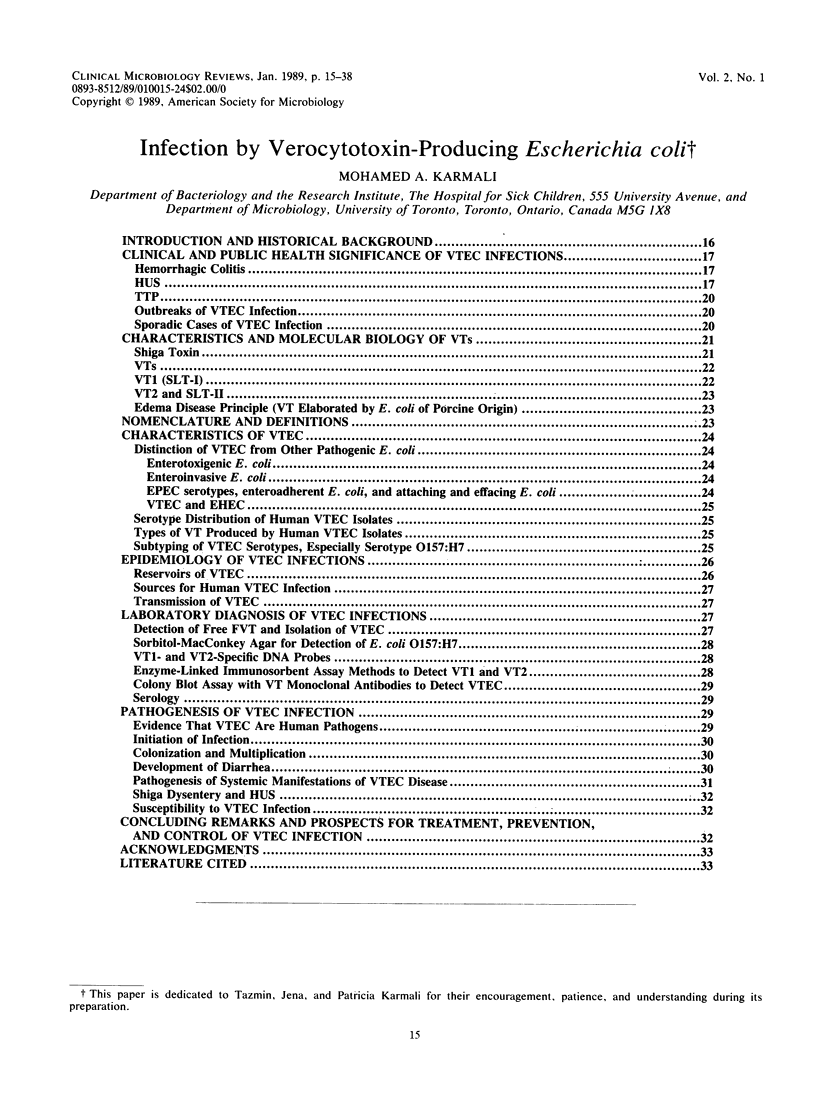
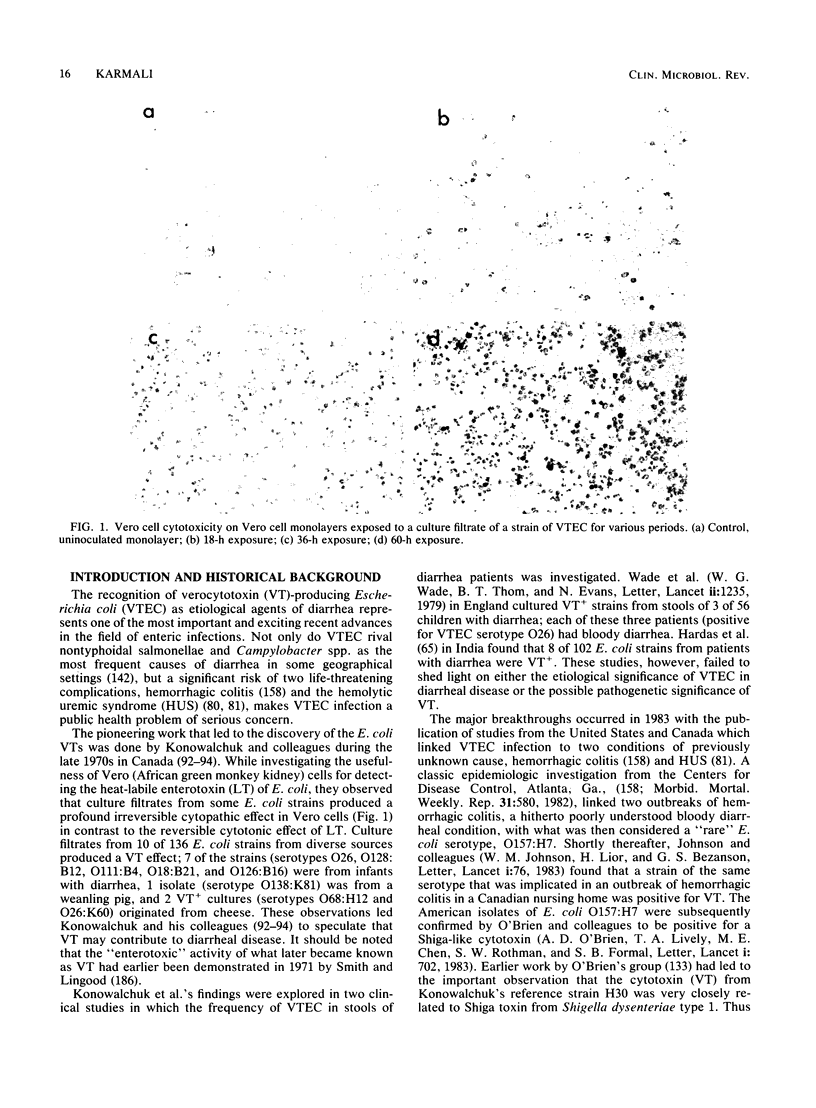
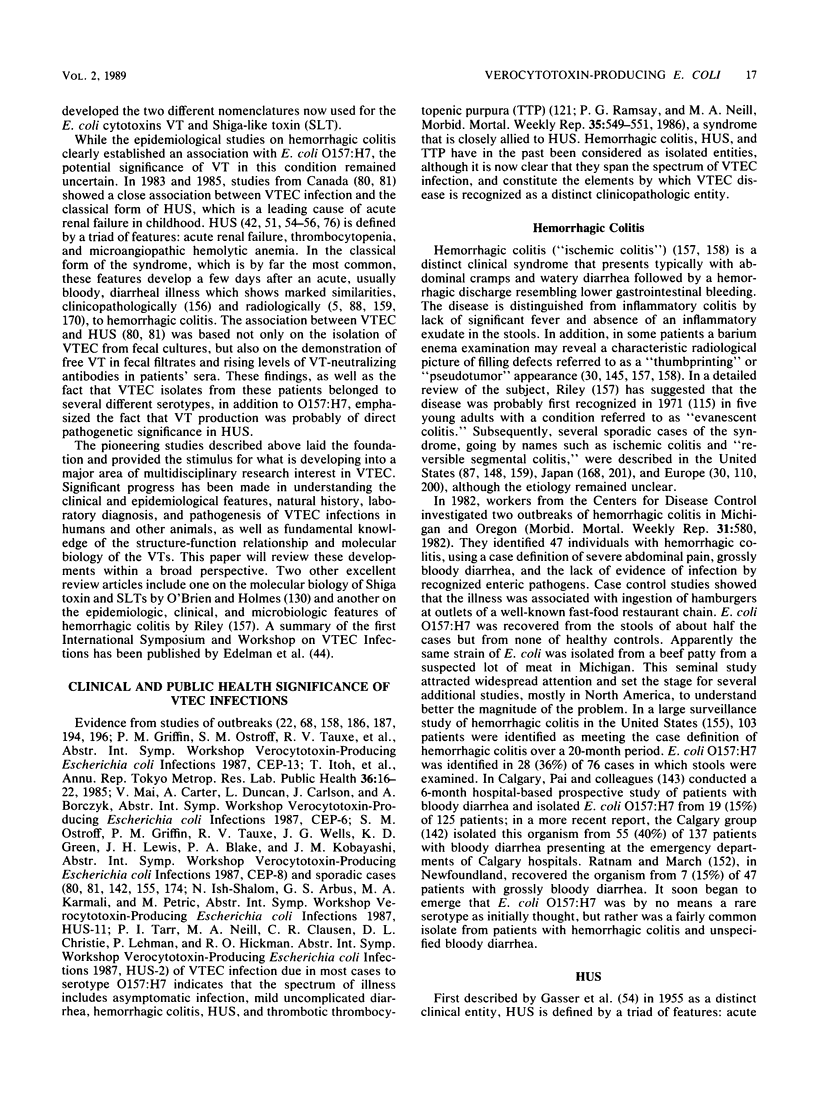
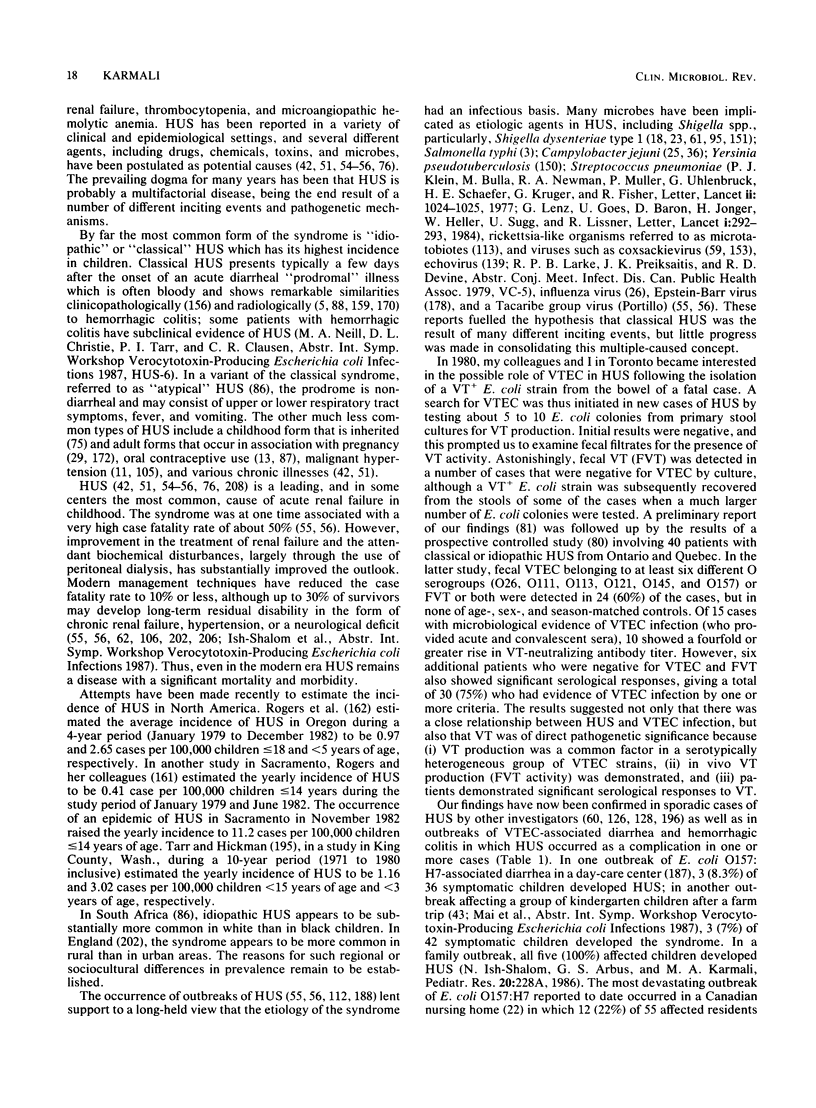
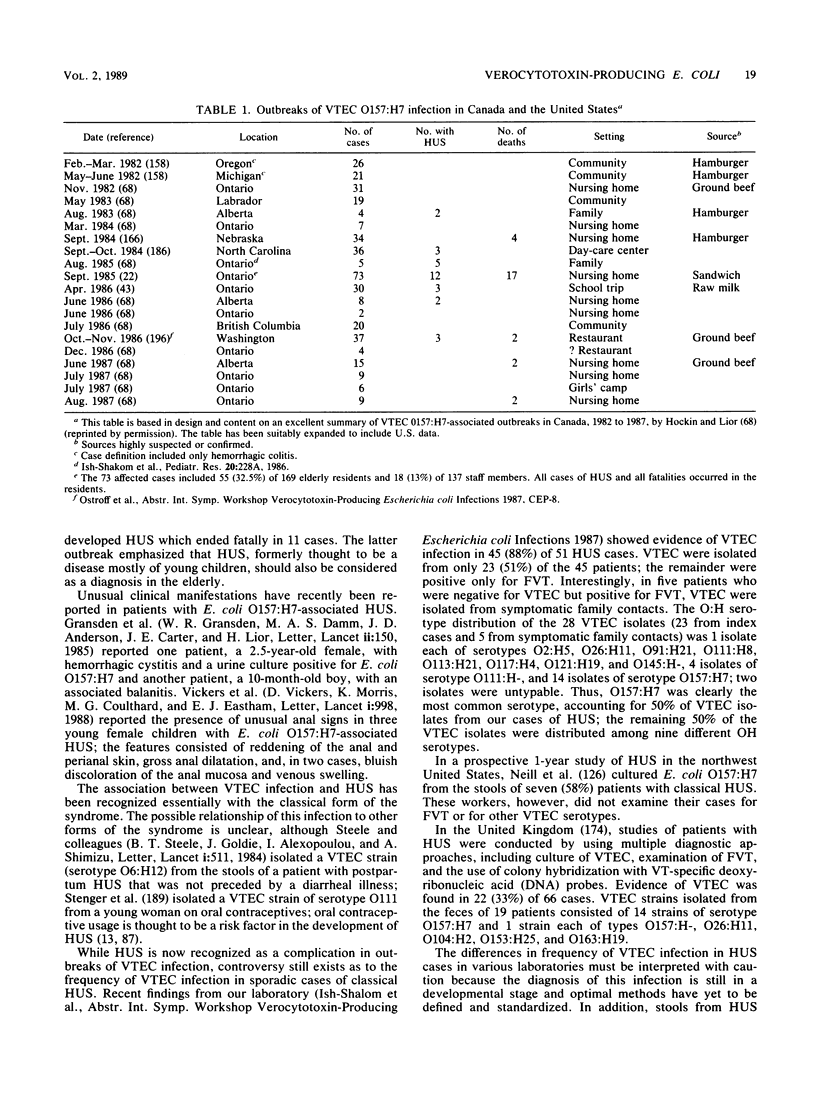
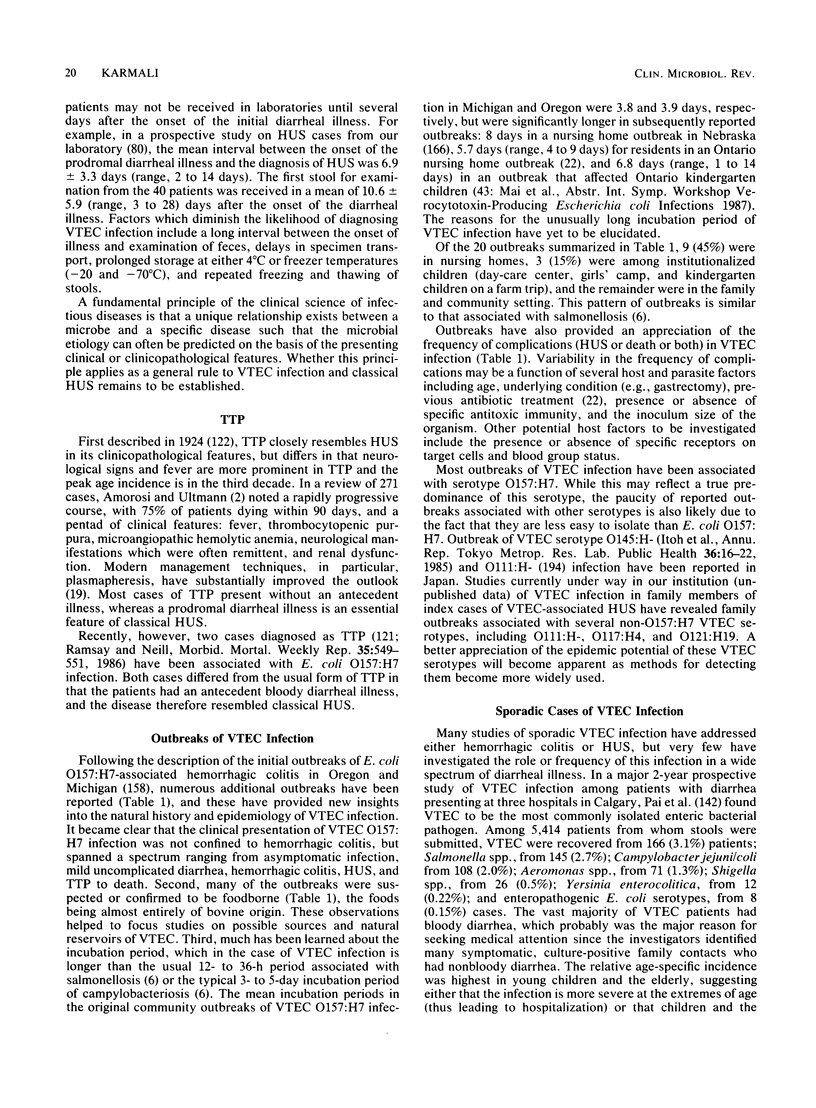
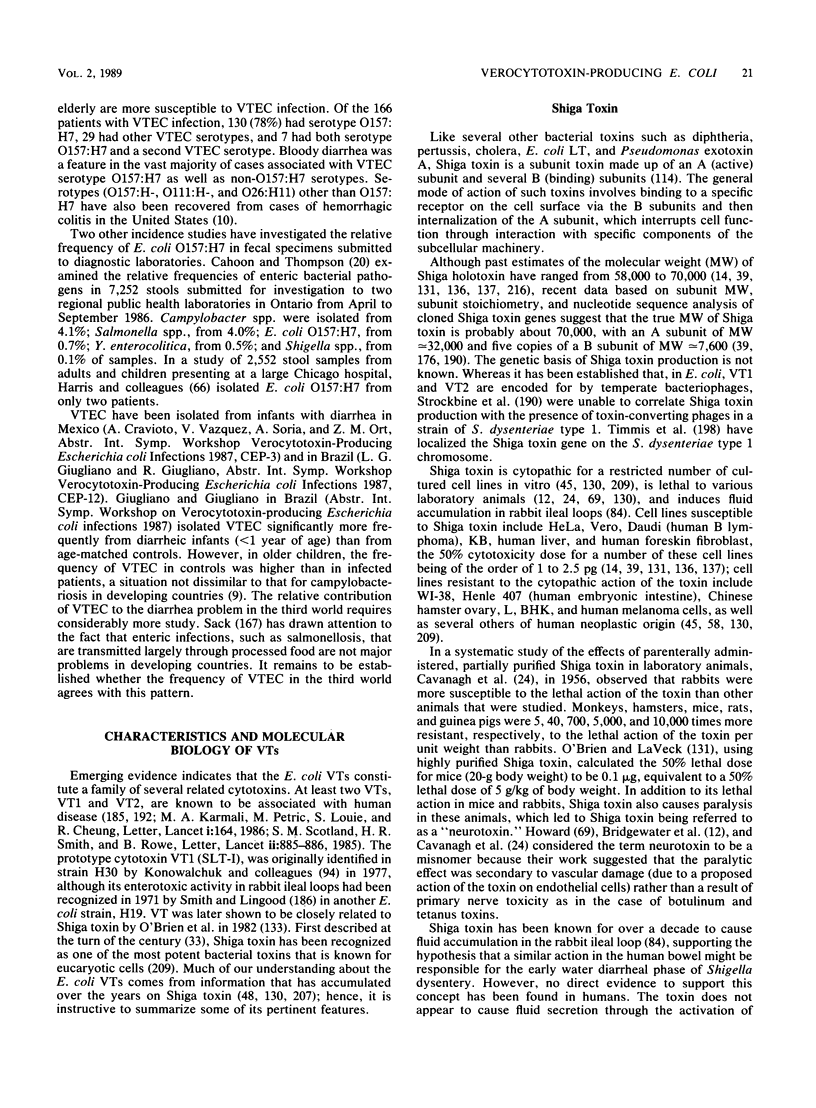
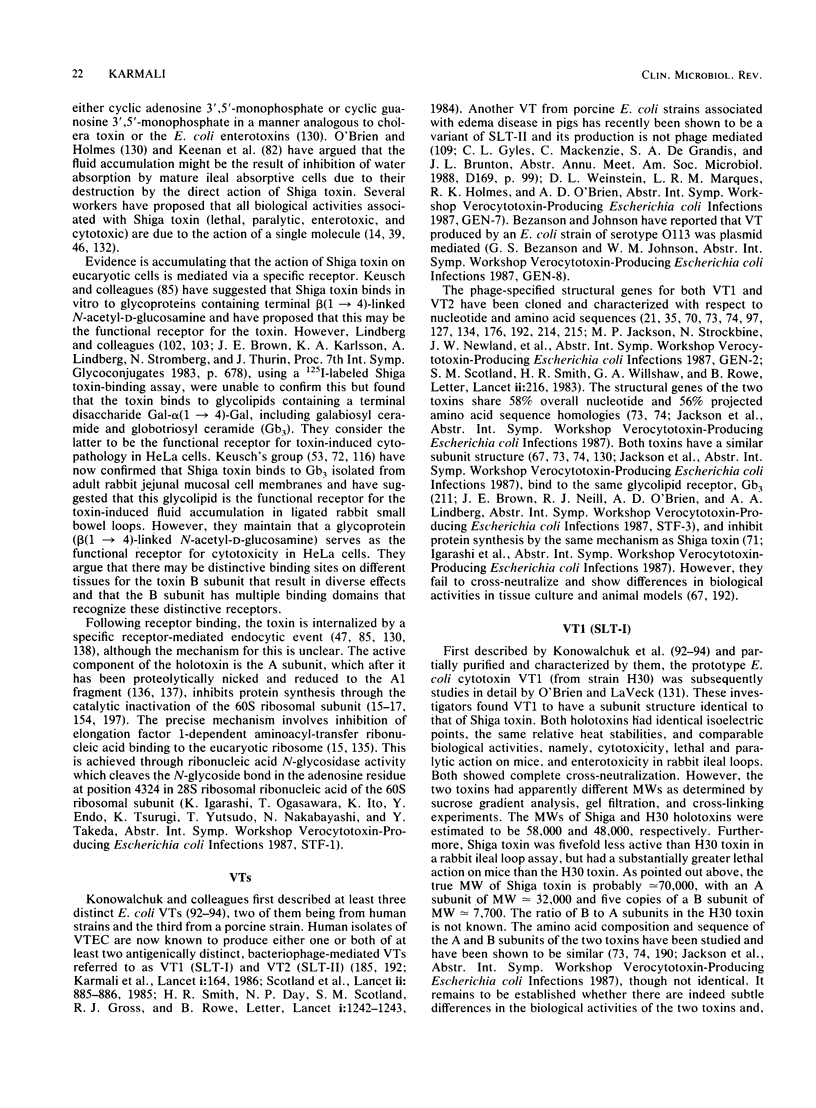
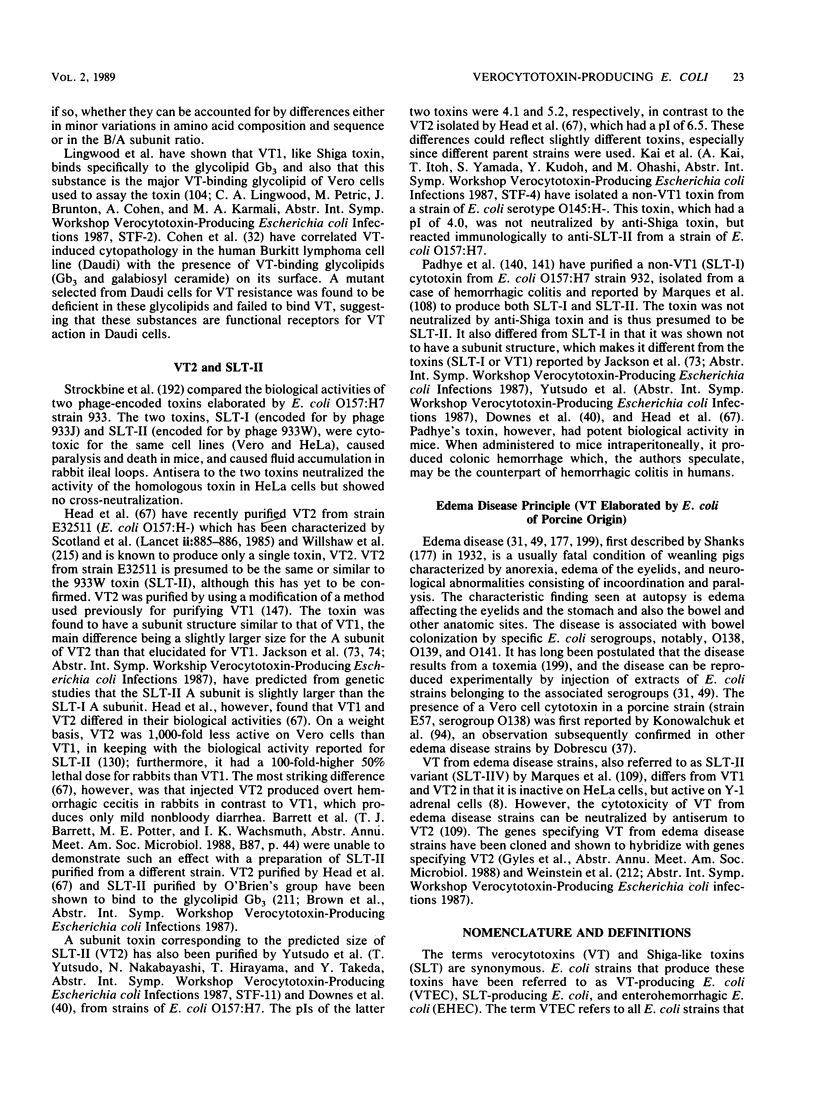
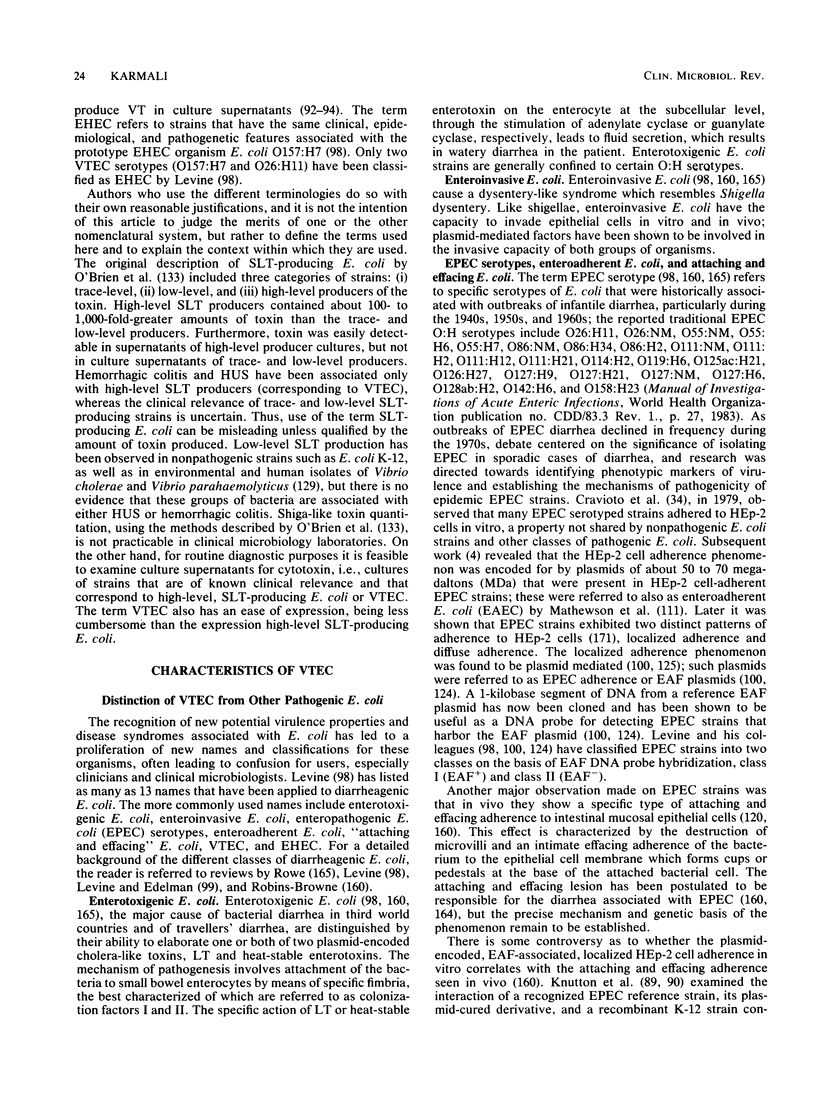
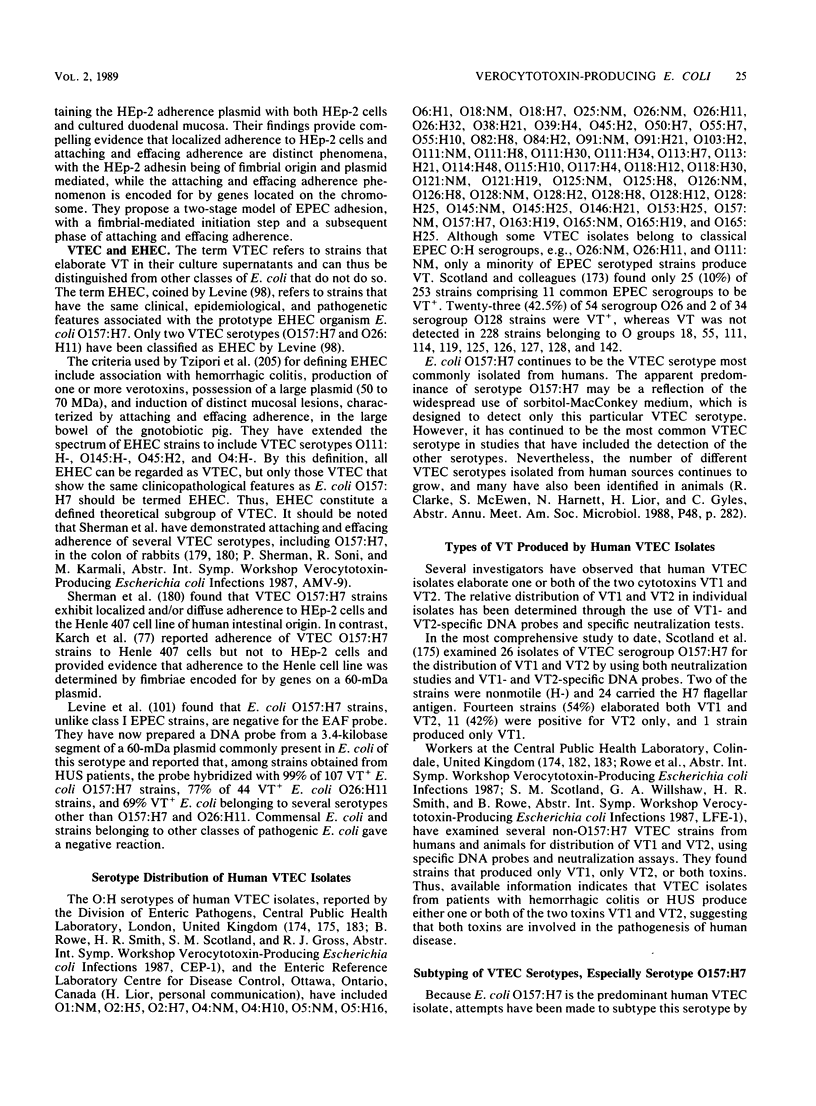
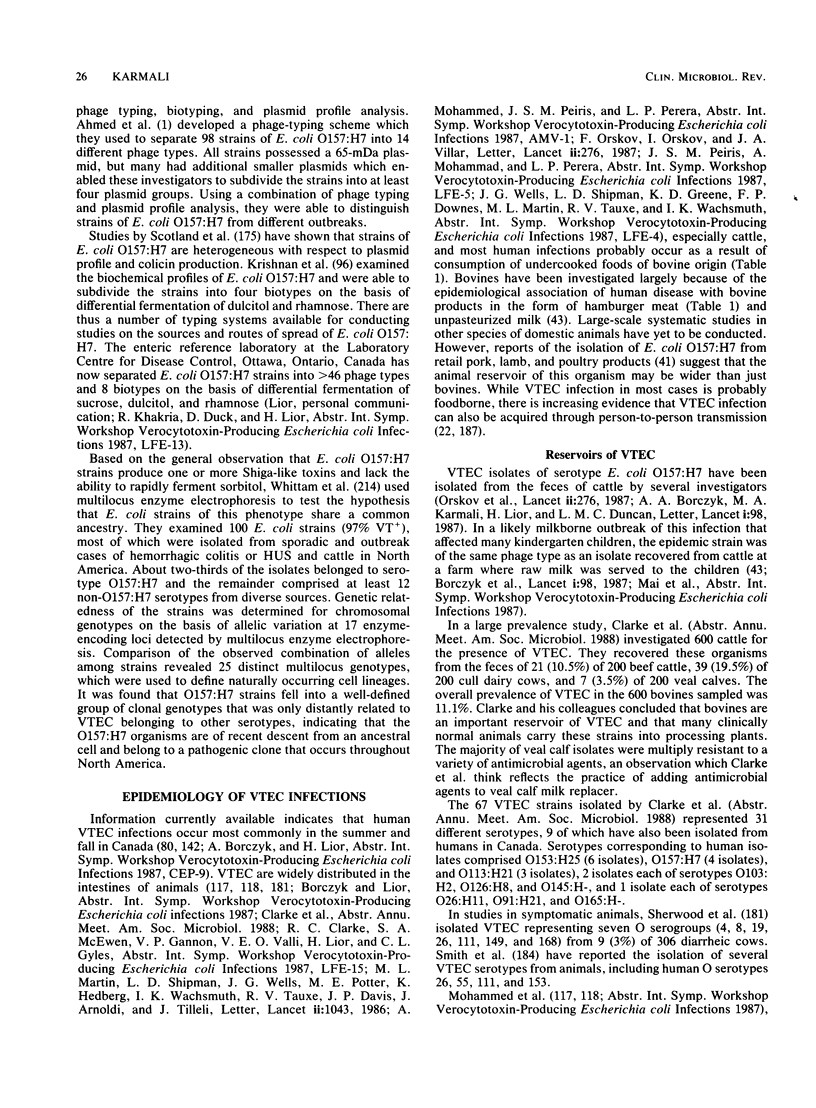
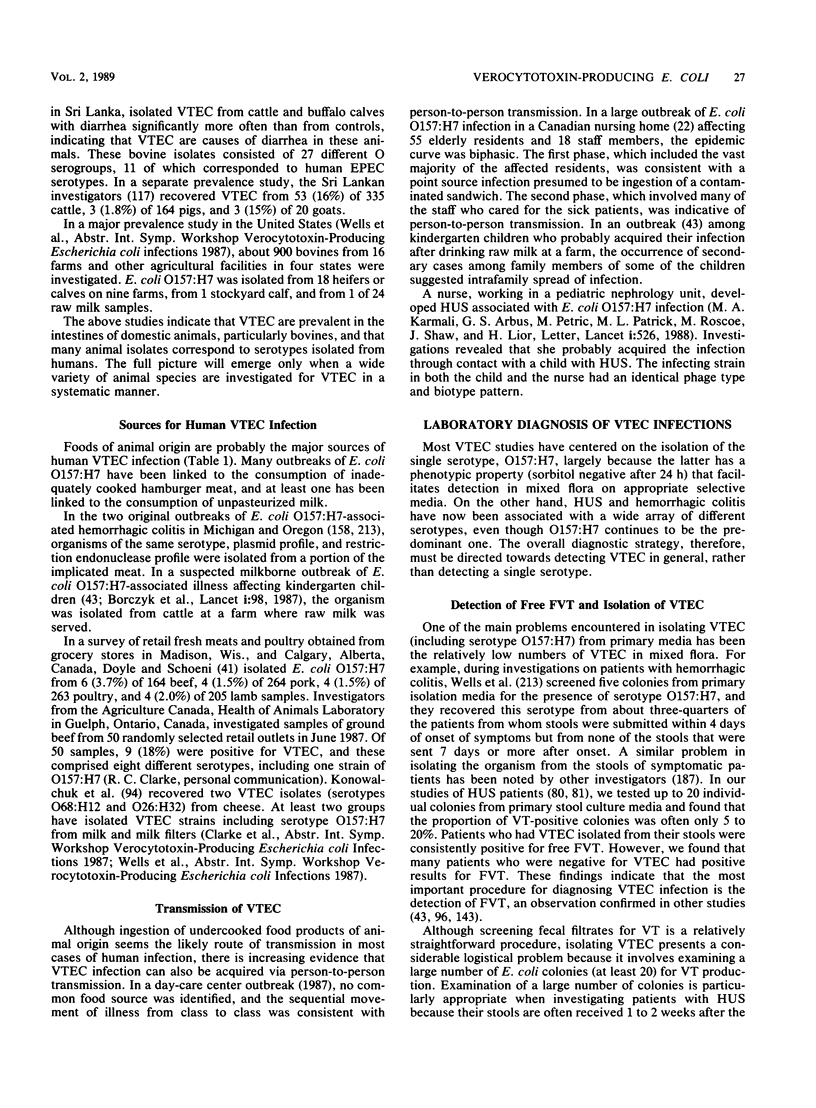
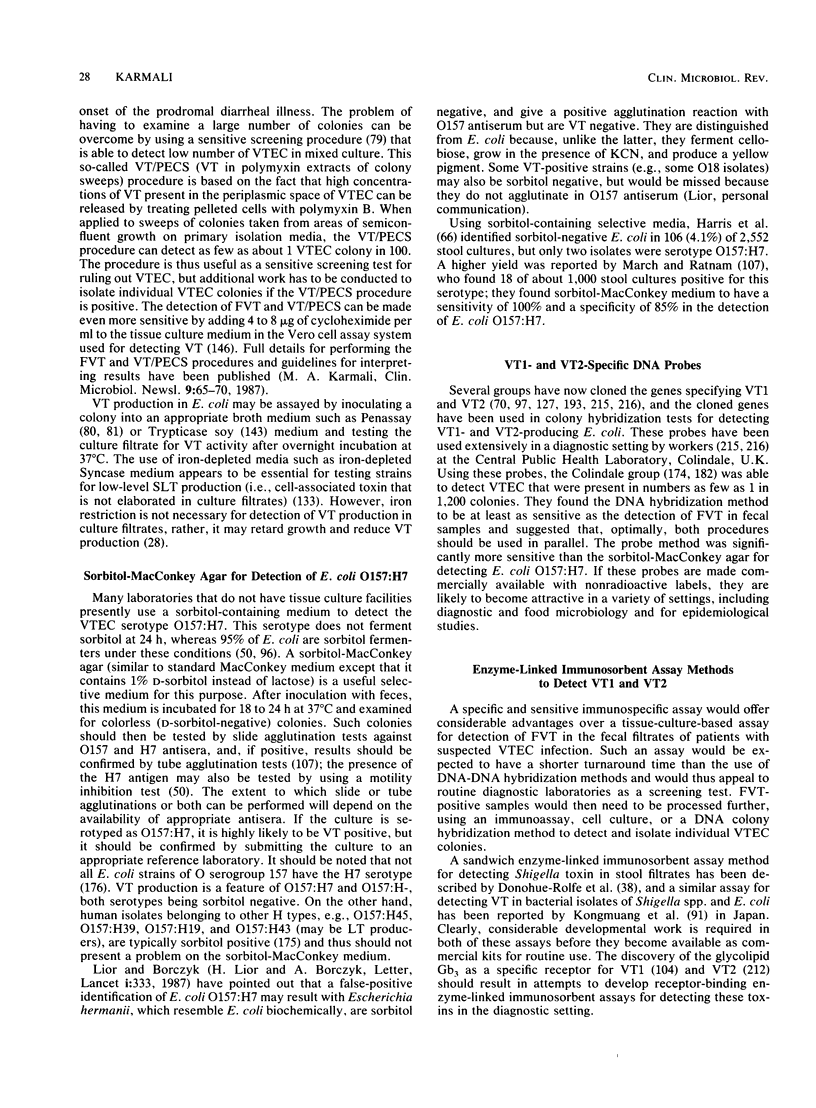
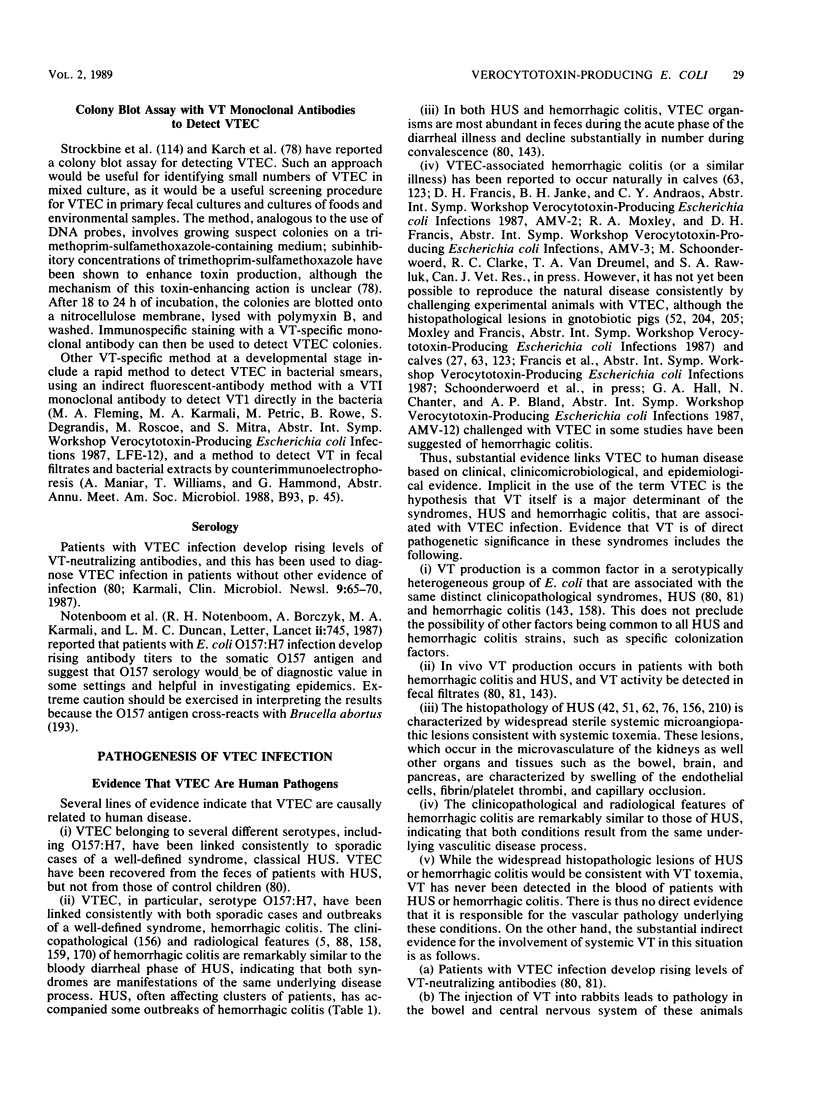
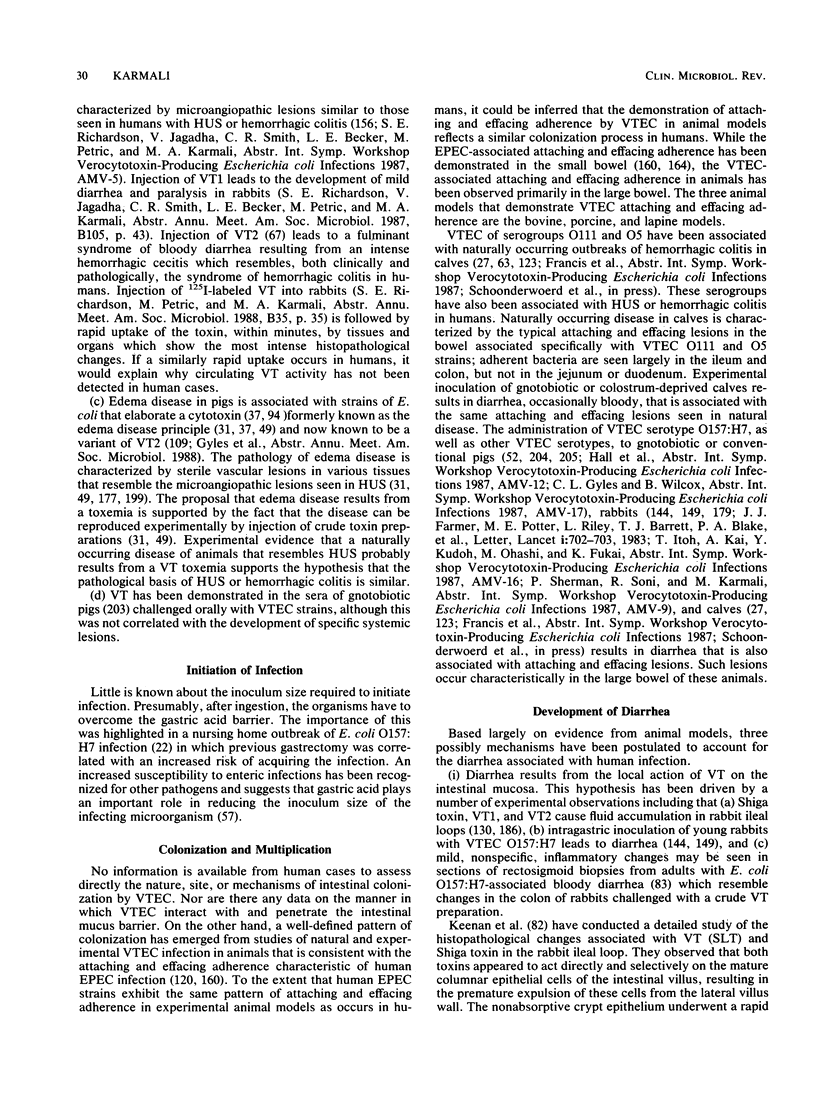
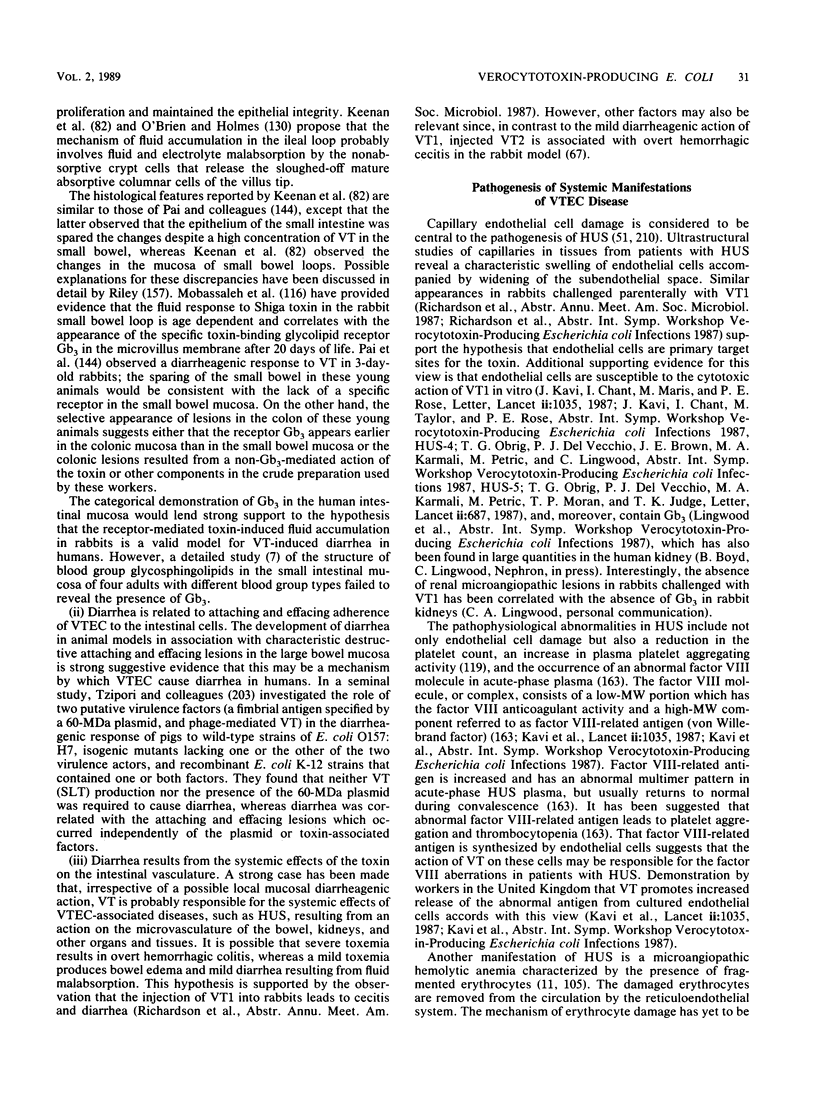
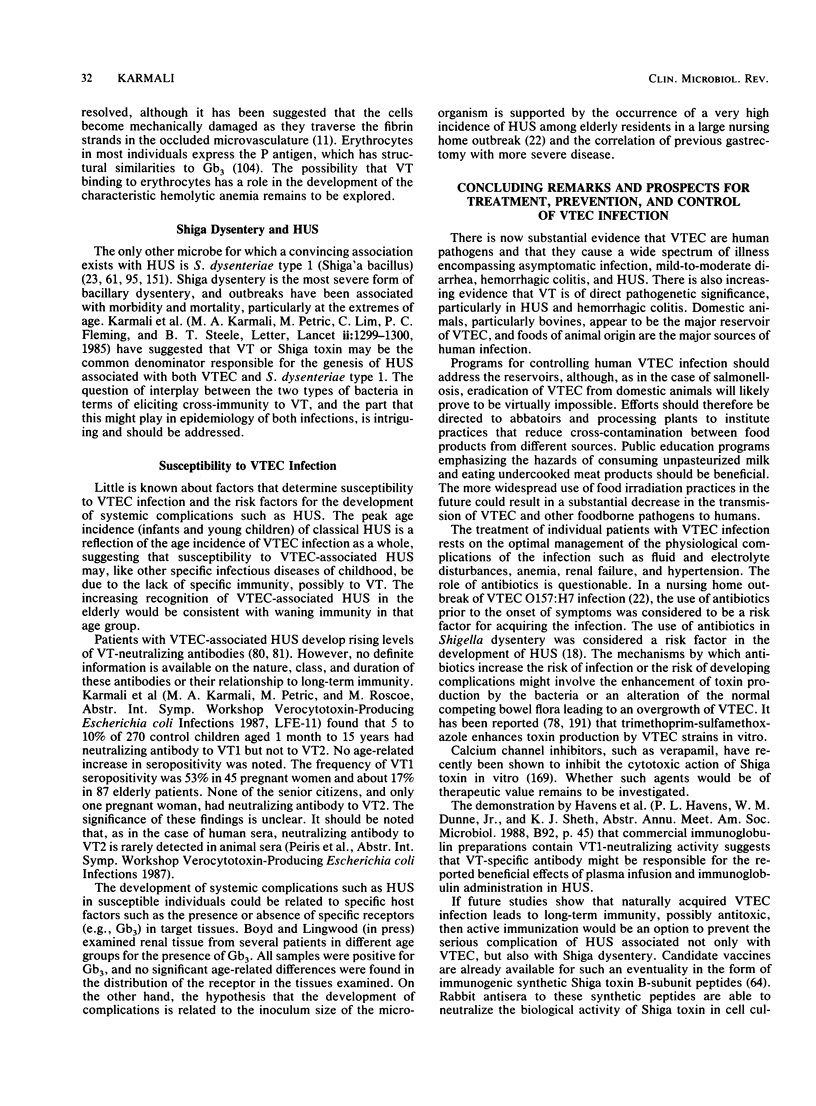
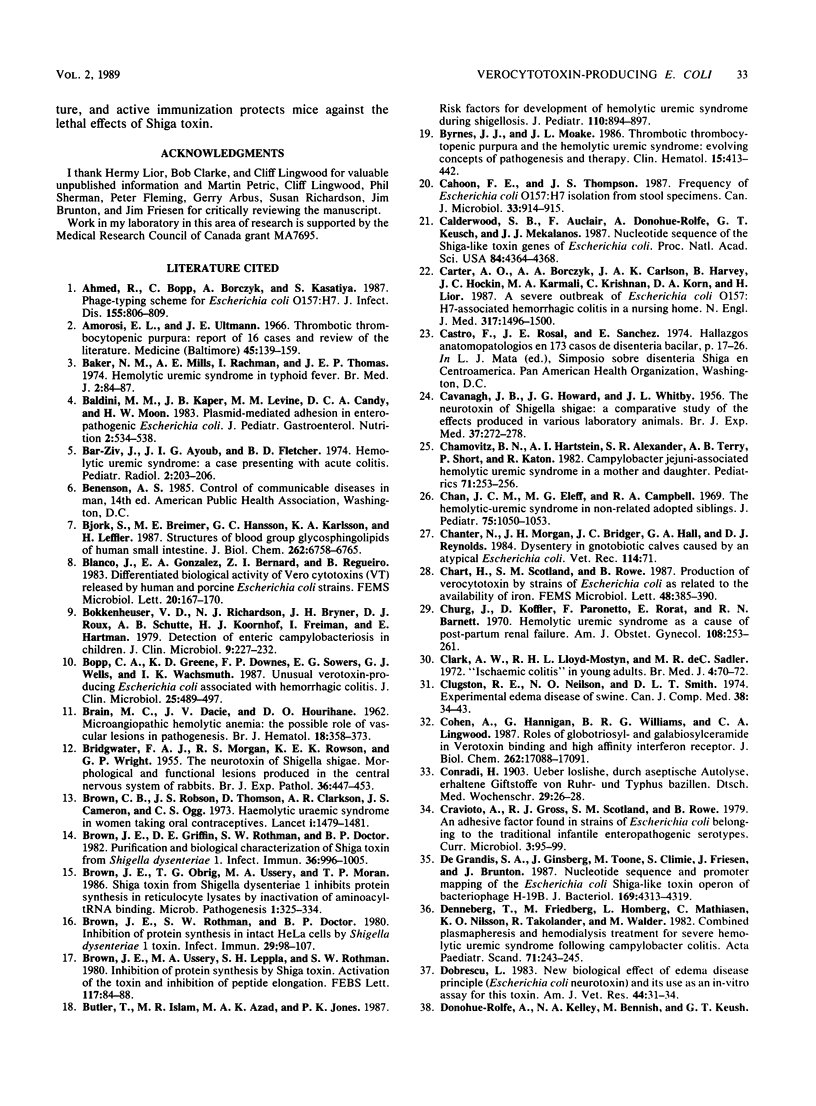
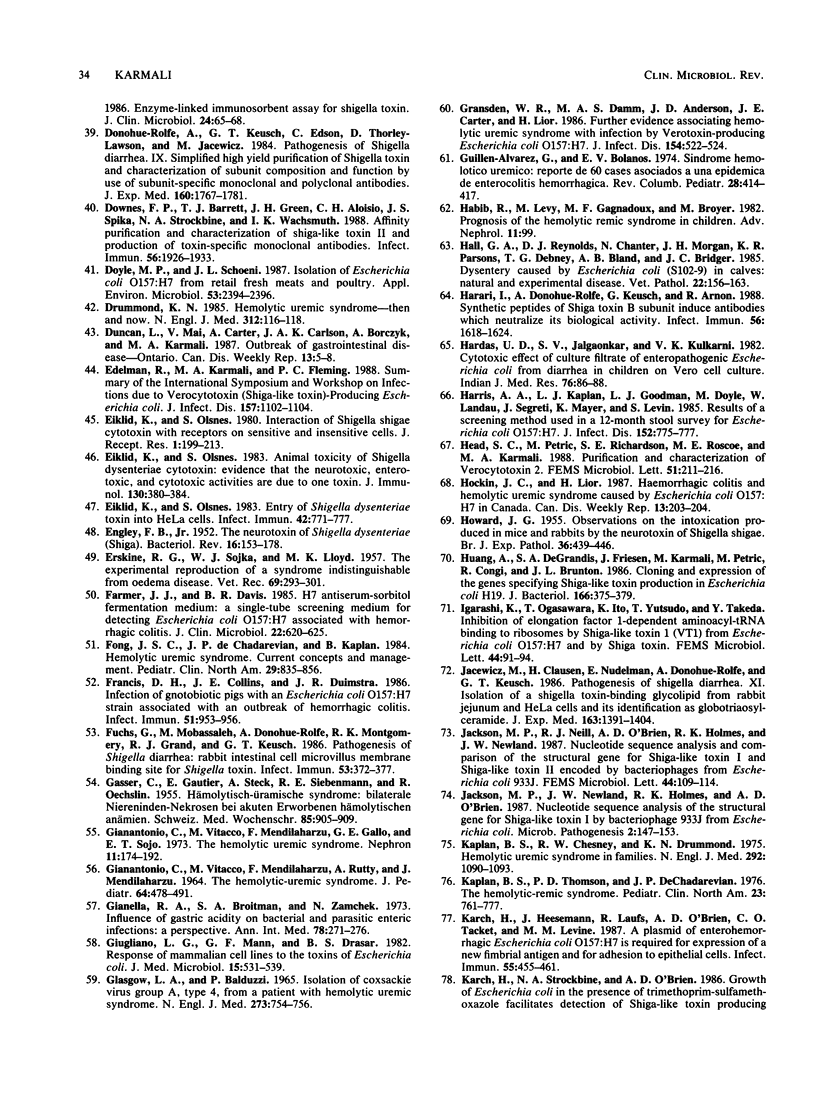
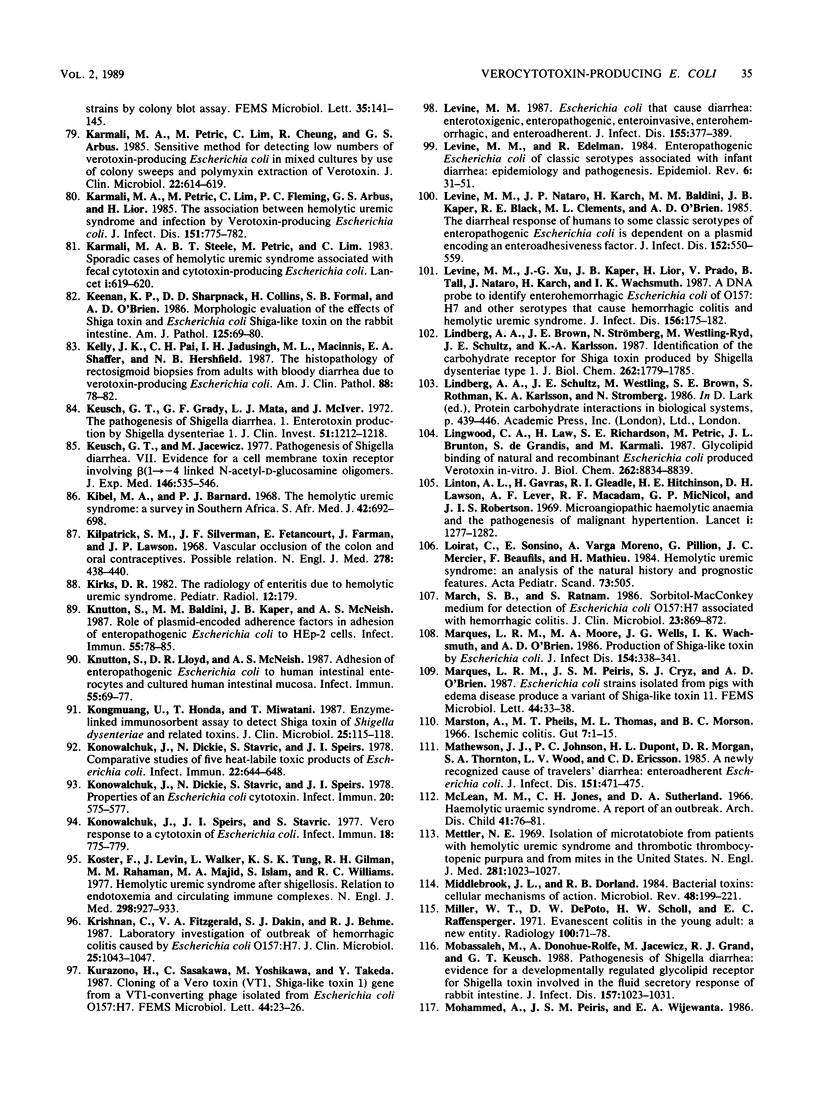
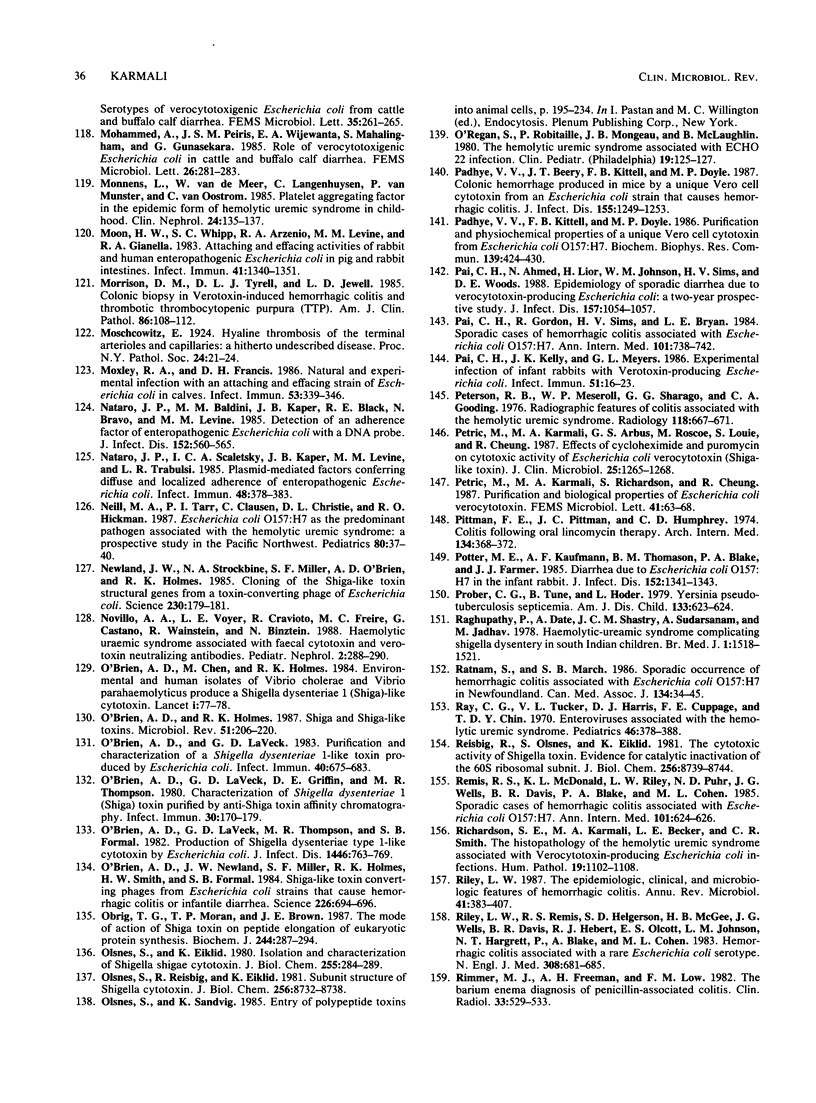
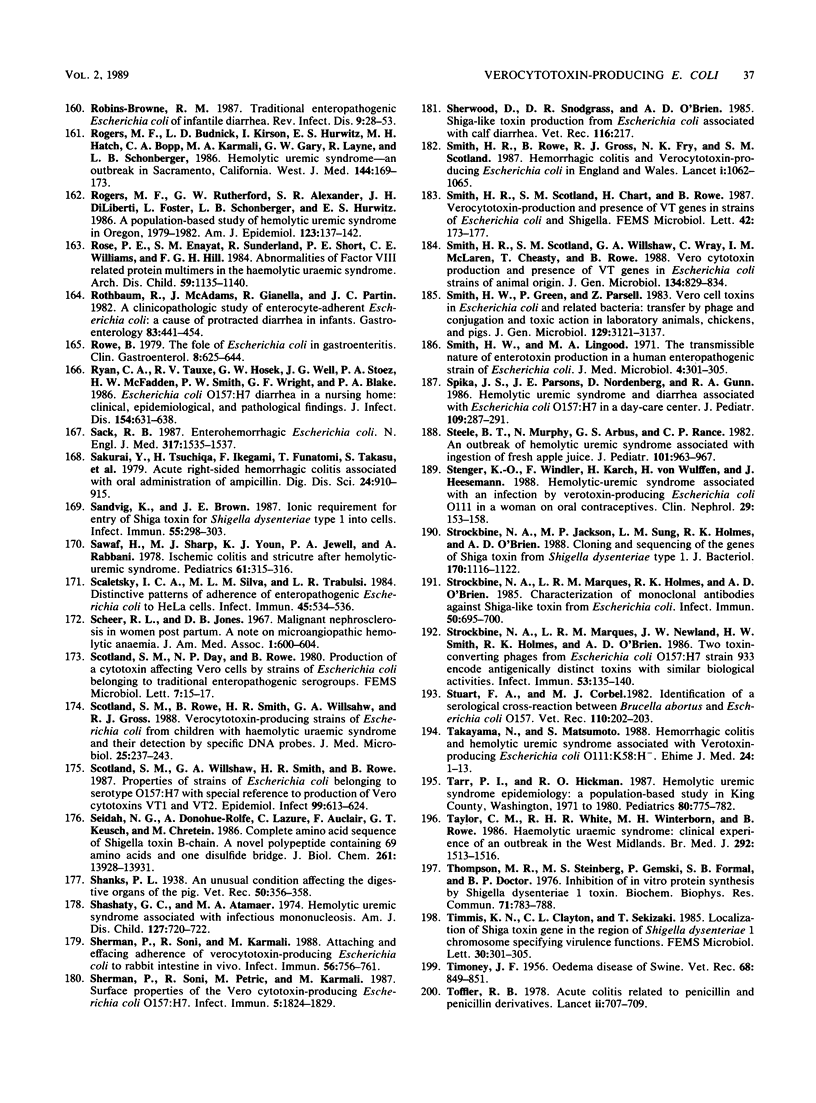

Images in this article
Selected References
These references are in PubMed. This may not be the complete list of references from this article.
- Ahmed R., Bopp C., Borczyk A., Kasatiya S. Phage-typing scheme for Escherichia coli O157:H7. J Infect Dis. 1987 Apr;155(4):806–809. doi: 10.1093/infdis/155.4.806. [DOI] [PubMed] [Google Scholar]
- BRAIN M. C., DACIE J. V., HOURIHANE D. O. Microangiopathic haemolytic anaemia: the possible role of vascular lesions in pathogenesis. Br J Haematol. 1962 Oct;8:358–374. doi: 10.1111/j.1365-2141.1962.tb06541.x. [DOI] [PubMed] [Google Scholar]
- BRIDGWATER F. A., MORGAN R. S., ROWSON K. E., WRIGHT G. P. The neurotoxin of Shigella shigae: morphological and functional lesions produced in the central nervous system of rabbits. Br J Exp Pathol. 1955 Oct;36(5):447–453. [PMC free article] [PubMed] [Google Scholar]
- Baker N. M., Mills A. E., Rachman I., Thomas J. E. Haemolytic-uraemic syndrome in typhoid fever. Br Med J. 1974 Apr 13;2(5910):84–87. doi: 10.1136/bmj.2.5910.84. [DOI] [PMC free article] [PubMed] [Google Scholar]
- Baldini M. M., Kaper J. B., Levine M. M., Candy D. C., Moon H. W. Plasmid-mediated adhesion in enteropathogenic Escherichia coli. J Pediatr Gastroenterol Nutr. 1983;2(3):534–538. doi: 10.1097/00005176-198302030-00023. [DOI] [PubMed] [Google Scholar]
- Bar-Ziv J., Ayoub J. I., Fletcher B. D. Hemolytic uremic syndrome: a case presenting with acute colitis. Pediatr Radiol. 1974;2(3):203–206. doi: 10.1007/BF00972734. [DOI] [PubMed] [Google Scholar]
- Björk S., Breimer M. E., Hansson G. C., Karlsson K. A., Leffler H. Structures of blood group glycosphingolipids of human small intestine. A relation between the expression of fucolipids of epithelial cells and the ABO, Le and Se phenotype of the donor. J Biol Chem. 1987 May 15;262(14):6758–6765. [PubMed] [Google Scholar]
- Bokkenheuser V. D., Richardson N. J., Bryner J. H., Roux D. J., Schutte A. B., Koornhof H. J., Freiman I., Hartman E. Detection of enteric campylobacteriosis in children. J Clin Microbiol. 1979 Feb;9(2):227–232. doi: 10.1128/jcm.9.2.227-232.1979. [DOI] [PMC free article] [PubMed] [Google Scholar]
- Brown C. B., Clarkson A. R., Robson J. S., Cameron J. S., Thomson D., Ogg C. S. Haemolytic uraemic syndrome in women taking oral contraceptives. Lancet. 1973 Jun 30;1(7818):1479–1481. doi: 10.1016/s0140-6736(73)91815-1. [DOI] [PubMed] [Google Scholar]
- Brown J. E., Griffin D. E., Rothman S. W., Doctor B. P. Purification and biological characterization of shiga toxin from Shigella dysenteriae 1. Infect Immun. 1982 Jun;36(3):996–1005. doi: 10.1128/iai.36.3.996-1005.1982. [DOI] [PMC free article] [PubMed] [Google Scholar]
- Brown J. E., Obrig T. G., Ussery M. A., Moran T. P. Shiga toxin from Shigella dysenteriae 1 inhibits protein synthesis in reticulocyte lysates by inactivation of aminoacyl-tRNA binding. Microb Pathog. 1986 Aug;1(4):325–334. doi: 10.1016/0882-4010(86)90065-3. [DOI] [PubMed] [Google Scholar]
- Brown J. E., Rothman S. W., Doctor B. P. Inhibition of protein synthesis in intact HeLa cells by Shigella dysenteriae 1 toxin. Infect Immun. 1980 Jul;29(1):98–107. doi: 10.1128/iai.29.1.98-107.1980. [DOI] [PMC free article] [PubMed] [Google Scholar]
- Brown J. E., Ussery M. A., Leppla S. H., Rothman S. W. Inhibition of protein synthesis by Shiga toxin: activation of the toxin and inhibition of peptide elongation. FEBS Lett. 1980 Aug 11;117(1):84–88. doi: 10.1016/0014-5793(80)80918-5. [DOI] [PubMed] [Google Scholar]
- Butler T., Islam M. R., Azad M. A., Jones P. K. Risk factors for development of hemolytic uremic syndrome during shigellosis. J Pediatr. 1987 Jun;110(6):894–897. doi: 10.1016/s0022-3476(87)80405-5. [DOI] [PubMed] [Google Scholar]
- Byrnes J. J., Moake J. L. Thrombotic thrombocytopenic purpura and the haemolytic-uraemic syndrome: evolving concepts of pathogenesis and therapy. Clin Haematol. 1986 May;15(2):413–442. [PubMed] [Google Scholar]
- CAVANAGH J. B., HOWARD J. G., WHITBY J. L. The neurotoxin of Shigella shigae; a comparative study of the effects produced in various laboratory animals. Br J Exp Pathol. 1956 Jun;37(3):272–278. [PMC free article] [PubMed] [Google Scholar]
- Cahoon F. E., Thompson J. S. Frequency of Escherichia coli O157:H7 isolation from stool specimens. Can J Microbiol. 1987 Oct;33(10):914–915. doi: 10.1139/m87-158. [DOI] [PubMed] [Google Scholar]
- Calderwood S. B., Auclair F., Donohue-Rolfe A., Keusch G. T., Mekalanos J. J. Nucleotide sequence of the Shiga-like toxin genes of Escherichia coli. Proc Natl Acad Sci U S A. 1987 Jul;84(13):4364–4368. doi: 10.1073/pnas.84.13.4364. [DOI] [PMC free article] [PubMed] [Google Scholar]
- Carter A. O., Borczyk A. A., Carlson J. A., Harvey B., Hockin J. C., Karmali M. A., Krishnan C., Korn D. A., Lior H. A severe outbreak of Escherichia coli O157:H7--associated hemorrhagic colitis in a nursing home. N Engl J Med. 1987 Dec 10;317(24):1496–1500. doi: 10.1056/NEJM198712103172403. [DOI] [PubMed] [Google Scholar]
- Chamovitz B. N., Hartstein A. I., Alexander S. R., Terry A. B., Short P., Katon R. Campylobacter jejuni-associated hemolytic-uremic syndrome in a mother and daughter. Pediatrics. 1983 Feb;71(2):253–256. [PubMed] [Google Scholar]
- Chan J. C., Eleff M. G., Campbell R. A. The hemolytic-uremic syndrome in nonrelated adopted siblings. J Pediatr. 1969 Dec;75(6):1050–1053. doi: 10.1016/s0022-3476(69)80346-x. [DOI] [PubMed] [Google Scholar]
- Chanter N., Morgan J. H., Bridger J. C., Hall G. A., Reynolds D. J. Dysentery in gnotobiotic calves caused by atypical Escherichia coli. Vet Rec. 1984 Jan 21;114(3):71–71. doi: 10.1136/vr.114.3.71. [DOI] [PubMed] [Google Scholar]
- Churg J., Koffler D., Paronetto F., Rorat E., Barnett R. N. Hemolytic uremic syndrome as a cause of postpartum renal failure. Am J Obstet Gynecol. 1970 Sep 15;108(2):253–261. doi: 10.1016/0002-9378(70)90307-8. [DOI] [PubMed] [Google Scholar]
- Clark A. W., Lloyd-Mostyn R. H., de Sadler M. R. "Ischaemic" colitis in young adults. Br Med J. 1972 Oct 14;4(5832):70–72. doi: 10.1136/bmj.4.5832.70. [DOI] [PMC free article] [PubMed] [Google Scholar]
- Clugston R. E., Nielsen N. O., Smith D. L. Experimental edema disease of swine (E. coli enterotoxemia). 3. Pathology and pathogenesis. Can J Comp Med. 1974 Jan;38(1):34–43. [PMC free article] [PubMed] [Google Scholar]
- Cohen A., Hannigan G. E., Williams B. R., Lingwood C. A. Roles of globotriosyl- and galabiosylceramide in verotoxin binding and high affinity interferon receptor. J Biol Chem. 1987 Dec 15;262(35):17088–17091. [PubMed] [Google Scholar]
- De Grandis S., Ginsberg J., Toone M., Climie S., Friesen J., Brunton J. Nucleotide sequence and promoter mapping of the Escherichia coli Shiga-like toxin operon of bacteriophage H-19B. J Bacteriol. 1987 Sep;169(9):4313–4319. doi: 10.1128/jb.169.9.4313-4319.1987. [DOI] [PMC free article] [PubMed] [Google Scholar]
- Denneberg T., Friedberg M., Holmberg L., Mathiasen C., Nilsson K. O., Takolander R., Walder M. Combined plasmapheresis and hemodialysis treatment for severe hemolytic-uremic syndrome following Campylobacter colitis. Acta Paediatr Scand. 1982 Mar;71(2):243–245. doi: 10.1111/j.1651-2227.1982.tb09408.x. [DOI] [PubMed] [Google Scholar]
- Dobrescu L. New biological effect of edema disease principle (Escherichia coli-neurotoxin) and its use as an in vitro for this toxin. Am J Vet Res. 1983 Jan;44(1):31–34. [PubMed] [Google Scholar]
- Donohue-Rolfe A., Keusch G. T., Edson C., Thorley-Lawson D., Jacewicz M. Pathogenesis of Shigella diarrhea. IX. Simplified high yield purification of Shigella toxin and characterization of subunit composition and function by the use of subunit-specific monoclonal and polyclonal antibodies. J Exp Med. 1984 Dec 1;160(6):1767–1781. doi: 10.1084/jem.160.6.1767. [DOI] [PMC free article] [PubMed] [Google Scholar]
- Downes F. P., Barrett T. J., Green J. H., Aloisio C. H., Spika J. S., Strockbine N. A., Wachsmuth I. K. Affinity purification and characterization of Shiga-like toxin II and production of toxin-specific monoclonal antibodies. Infect Immun. 1988 Aug;56(8):1926–1933. doi: 10.1128/iai.56.8.1926-1933.1988. [DOI] [PMC free article] [PubMed] [Google Scholar]
- Doyle M. P., Schoeni J. L. Isolation of Escherichia coli O157:H7 from retail fresh meats and poultry. Appl Environ Microbiol. 1987 Oct;53(10):2394–2396. doi: 10.1128/aem.53.10.2394-2396.1987. [DOI] [PMC free article] [PubMed] [Google Scholar]
- Drummond K. N. Hemolytic uremic syndrome--then and now. N Engl J Med. 1985 Jan 10;312(2):116–118. doi: 10.1056/NEJM198501103120211. [DOI] [PubMed] [Google Scholar]
- ENGLEY F. B., Jr The neurotoxin of Shigella dysenteriae (shiga). Bacteriol Rev. 1952 Sep;16(3):153–178. doi: 10.1128/br.16.3.153-178.1952. [DOI] [PMC free article] [PubMed] [Google Scholar]
- Edelman R., Karmali M. A., Fleming P. A. From the National Institutes of Health. Summary of the International Symposium and Workshop on Infections due to Verocytotoxin (Shiga-like toxin)-producing Escherichia coli. J Infect Dis. 1988 May;157(5):1102–1104. doi: 10.1093/infdis/157.5.1102. [DOI] [PubMed] [Google Scholar]
- Eiklid K., Olsnes S. Animal toxicity of Shigella dysenteriae cytotoxin: evidence that the neurotoxic, enterotoxic, and cytotoxic activities are due to one toxin. J Immunol. 1983 Jan;130(1):380–384. [PubMed] [Google Scholar]
- Eiklid K., Olsnes S. Entry of Shigella dysenteriae toxin into HeLa cells. Infect Immun. 1983 Nov;42(2):771–777. doi: 10.1128/iai.42.2.771-777.1983. [DOI] [PMC free article] [PubMed] [Google Scholar]
- Eiklid K., Olsnes S. Interaction of Shigella shigae cytotoxin with receptors on sensitive and insensitive cells. J Recept Res. 1980;1(2):199–213. doi: 10.3109/10799898009044098. [DOI] [PubMed] [Google Scholar]
- Farmer J. J., 3rd, Davis B. R. H7 antiserum-sorbitol fermentation medium: a single tube screening medium for detecting Escherichia coli O157:H7 associated with hemorrhagic colitis. J Clin Microbiol. 1985 Oct;22(4):620–625. doi: 10.1128/jcm.22.4.620-625.1985. [DOI] [PMC free article] [PubMed] [Google Scholar]
- Fong J. S., de Chadarevian J. P., Kaplan B. S. Hemolytic-uremic syndrome. Current concepts and management. Pediatr Clin North Am. 1982 Aug;29(4):835–856. doi: 10.1016/s0031-3955(16)34216-x. [DOI] [PubMed] [Google Scholar]
- Francis D. H., Collins J. E., Duimstra J. R. Infection of gnotobiotic pigs with an Escherichia coli O157:H7 strain associated with an outbreak of hemorrhagic colitis. Infect Immun. 1986 Mar;51(3):953–956. doi: 10.1128/iai.51.3.953-956.1986. [DOI] [PMC free article] [PubMed] [Google Scholar]
- Fuchs G., Mobassaleh M., Donohue-Rolfe A., Montgomery R. K., Grand R. J., Keusch G. T. Pathogenesis of Shigella diarrhea: rabbit intestinal cell microvillus membrane binding site for Shigella toxin. Infect Immun. 1986 Aug;53(2):372–377. doi: 10.1128/iai.53.2.372-377.1986. [DOI] [PMC free article] [PubMed] [Google Scholar]
- GASSER C., GAUTIER E., STECK A., SIEBENMANN R. E., OECHSLIN R. Hämolytisch-urämische Syndrome: bilaterale Nierenrindennekrosen bei akuten erworbenen hämolytischen Anämien. Schweiz Med Wochenschr. 1955 Sep 20;85(38-39):905–909. [PubMed] [Google Scholar]
- GIANANTONIO C., VITACCO M., MENDILAHARZU F., RUTTY A., MENDILAHARZU J. THE HEMOLYTIC-UREMIC SYNDROME. J Pediatr. 1964 Apr;64:478–491. doi: 10.1016/s0022-3476(64)80337-1. [DOI] [PubMed] [Google Scholar]
- Gianantonio C. A., Vitacco M., Mendilaharzu F., Gallo G. E., Sojo E. T. The hemolytic-uremic syndrome. Nephron. 1973;11(2):174–192. doi: 10.1159/000180229. [DOI] [PubMed] [Google Scholar]
- Giannella R. A., Broitman S. A., Zamcheck N. Influence of gastric acidity on bacterial and parasitic enteric infections. A perspective. Ann Intern Med. 1973 Feb;78(2):271–276. doi: 10.7326/0003-4819-78-2-271. [DOI] [PubMed] [Google Scholar]
- Giugliano L. G., Mann G. F., Drasar B. S. Response of mammalian cell lines to the toxins of Escherichia coli. J Med Microbiol. 1982 Nov;15(4):531–539. doi: 10.1099/00222615-15-4-531. [DOI] [PubMed] [Google Scholar]
- Glasgow L. A., Balduzzi P. Isolation of Coxsackie virus group A, type 4, from a patient with hemolytic-uremic syndrome. N Engl J Med. 1965 Sep 30;273(14):754–756. doi: 10.1056/NEJM196509302731407. [DOI] [PubMed] [Google Scholar]
- Gransden W. R., Damm M. A., Anderson J. D., Carter J. E., Lior H. Further evidence associating hemolytic uremic syndrome with infection by Verotoxin-producing Escherichia coli O157:H7. J Infect Dis. 1986 Sep;154(3):522–524. doi: 10.1093/infdis/154.3.522. [DOI] [PubMed] [Google Scholar]
- HOWARD J. G. Observations on the intoxication produced in mice and rabbits by the neurotoxin of Shigella shigae. Br J Exp Pathol. 1955 Oct;36(5):439–446. [PMC free article] [PubMed] [Google Scholar]
- Hall G. A., Reynolds D. J., Chanter N., Morgan J. H., Parsons K. R., Debney T. G., Bland A. P., Bridger J. C. Dysentery caused by Escherichia coli (S102-9) in calves: natural and experimental disease. Vet Pathol. 1985 Mar;22(2):156–163. doi: 10.1177/030098588502200210. [DOI] [PubMed] [Google Scholar]
- Harari I., Donohue-Rolfe A., Keusch G., Arnon R. Synthetic peptides of Shiga toxin B subunit induce antibodies which neutralize its biological activity. Infect Immun. 1988 Jun;56(6):1618–1624. doi: 10.1128/iai.56.6.1618-1624.1988. [DOI] [PMC free article] [PubMed] [Google Scholar]
- Hardas U. D., Jalgaonkar S. V., Kulkarni V. K. Cytotoxic effect of culture filtrate of enteropathogenic Escherichia coli from diarrhoea in children on Vero cell culture. Indian J Med Res. 1982 Jul;76:86–88. [PubMed] [Google Scholar]
- Harris A. A., Kaplan R. L., Goodman L. J., Doyle M., Landau W., Segreti J., Mayer K., Levin S. Results of a screening method used in a 12-month stool survey for Escherichia coli O157:H7. J Infect Dis. 1985 Oct;152(4):775–777. doi: 10.1093/infdis/152.4.775. [DOI] [PubMed] [Google Scholar]
- Huang A., de Grandis S., Friesen J., Karmali M., Petric M., Congi R., Brunton J. L. Cloning and expression of the genes specifying Shiga-like toxin production in Escherichia coli H19. J Bacteriol. 1986 May;166(2):375–379. doi: 10.1128/jb.166.2.375-379.1986. [DOI] [PMC free article] [PubMed] [Google Scholar]
- Jacewicz M., Clausen H., Nudelman E., Donohue-Rolfe A., Keusch G. T. Pathogenesis of shigella diarrhea. XI. Isolation of a shigella toxin-binding glycolipid from rabbit jejunum and HeLa cells and its identification as globotriaosylceramide. J Exp Med. 1986 Jun 1;163(6):1391–1404. doi: 10.1084/jem.163.6.1391. [DOI] [PMC free article] [PubMed] [Google Scholar]
- Jackson M. P., Newland J. W., Holmes R. K., O'Brien A. D. Nucleotide sequence analysis of the structural genes for Shiga-like toxin I encoded by bacteriophage 933J from Escherichia coli. Microb Pathog. 1987 Feb;2(2):147–153. doi: 10.1016/0882-4010(87)90106-9. [DOI] [PubMed] [Google Scholar]
- Kaplan B. S., Chesney R. W., Drummond K. N. Hemolytic uremic syndrome in families. N Engl J Med. 1975 May 22;292(21):1090–1093. doi: 10.1056/NEJM197505222922102. [DOI] [PubMed] [Google Scholar]
- Kaplan B. S., Thomson P. D., de Chadarévian J. P. The hemolytic uremic syndrome. Pediatr Clin North Am. 1976 Nov;23(4):761–777. doi: 10.1016/s0031-3955(16)33359-4. [DOI] [PubMed] [Google Scholar]
- Karch H., Heesemann J., Laufs R., O'Brien A. D., Tacket C. O., Levine M. M. A plasmid of enterohemorrhagic Escherichia coli O157:H7 is required for expression of a new fimbrial antigen and for adhesion to epithelial cells. Infect Immun. 1987 Feb;55(2):455–461. doi: 10.1128/iai.55.2.455-461.1987. [DOI] [PMC free article] [PubMed] [Google Scholar]
- Karmali M. A., Petric M., Lim C., Cheung R., Arbus G. S. Sensitive method for detecting low numbers of verotoxin-producing Escherichia coli in mixed cultures by use of colony sweeps and polymyxin extraction of verotoxin. J Clin Microbiol. 1985 Oct;22(4):614–619. doi: 10.1128/jcm.22.4.614-619.1985. [DOI] [PMC free article] [PubMed] [Google Scholar]
- Karmali M. A., Petric M., Lim C., Fleming P. C., Arbus G. S., Lior H. The association between idiopathic hemolytic uremic syndrome and infection by verotoxin-producing Escherichia coli. J Infect Dis. 1985 May;151(5):775–782. doi: 10.1093/infdis/151.5.775. [DOI] [PubMed] [Google Scholar]
- Karmali M. A., Steele B. T., Petric M., Lim C. Sporadic cases of haemolytic-uraemic syndrome associated with faecal cytotoxin and cytotoxin-producing Escherichia coli in stools. Lancet. 1983 Mar 19;1(8325):619–620. doi: 10.1016/s0140-6736(83)91795-6. [DOI] [PubMed] [Google Scholar]
- Keenan K. P., Sharpnack D. D., Collins H., Formal S. B., O'Brien A. D. Morphologic evaluation of the effects of Shiga toxin and E coli Shiga-like toxin on the rabbit intestine. Am J Pathol. 1986 Oct;125(1):69–80. [PMC free article] [PubMed] [Google Scholar]
- Kelly J. K., Pai C. H., Jadusingh I. H., Macinnis M. L., Shaffer E. A., Hershfield N. B. The histopathology of rectosigmoid biopsies from adults with bloody diarrhea due to verotoxin-producing Escherichia coli. Am J Clin Pathol. 1987 Jul;88(1):78–82. doi: 10.1093/ajcp/88.1.78. [DOI] [PubMed] [Google Scholar]
- Keusch G. T., Grady G. F., Mata L. J., McIver J. The pathogenesis of Shigella diarrhea. I. Enterotoxin production by Shigella dysenteriae I. J Clin Invest. 1972 May;51(5):1212–1218. doi: 10.1172/JCI106915. [DOI] [PMC free article] [PubMed] [Google Scholar]
- Keusch G. T., Jacewicz M. Pathogenesis of Shigella diarrhea. VII. Evidence for a cell membrane toxin receptor involving beta1 leads to 4-linked N-acetyl-D-glucosamine oligomers. J Exp Med. 1977 Aug 1;146(2):535–546. doi: 10.1084/jem.146.2.535. [DOI] [PMC free article] [PubMed] [Google Scholar]
- Kibel M. A., Barnard P. J. The haemolytic-uraemic syndrome: a survey in Southern Africa. S Afr Med J. 1968 Jul 13;42(27):692–698. [PubMed] [Google Scholar]
- Kilpatrick Z. M., Silverman J. F., Betancourt E., Farman J., Lawson J. P. Vascular occlusion of the colon and oral contraceptives. Possible relation. N Engl J Med. 1968 Feb 22;278(8):438–440. doi: 10.1056/NEJM196802222780807. [DOI] [PubMed] [Google Scholar]
- Kirks D. R. The radiology of enteritis due to hemolytic-uremic syndrome. Pediatr Radiol. 1982;12(4):179–183. doi: 10.1007/BF00999307. [DOI] [PubMed] [Google Scholar]
- Knutton S., Baldini M. M., Kaper J. B., McNeish A. S. Role of plasmid-encoded adherence factors in adhesion of enteropathogenic Escherichia coli to HEp-2 cells. Infect Immun. 1987 Jan;55(1):78–85. doi: 10.1128/iai.55.1.78-85.1987. [DOI] [PMC free article] [PubMed] [Google Scholar]
- Knutton S., Lloyd D. R., McNeish A. S. Adhesion of enteropathogenic Escherichia coli to human intestinal enterocytes and cultured human intestinal mucosa. Infect Immun. 1987 Jan;55(1):69–77. doi: 10.1128/iai.55.1.69-77.1987. [DOI] [PMC free article] [PubMed] [Google Scholar]
- Kongmuang U., Honda T., Miwatani T. Enzyme-linked immunosorbent assay to detect Shiga toxin of Shigella dysenteriae and related toxins. J Clin Microbiol. 1987 Jan;25(1):115–118. doi: 10.1128/jcm.25.1.115-118.1987. [DOI] [PMC free article] [PubMed] [Google Scholar]
- Konowalchuk J., Dickie N., Stavric S., Speirs J. I. Comparative studies of five heat-labile toxic products of Escherichia coli. Infect Immun. 1978 Dec;22(3):644–648. doi: 10.1128/iai.22.3.644-648.1978. [DOI] [PMC free article] [PubMed] [Google Scholar]
- Konowalchuk J., Dickie N., Stavric S., Speirs J. I. Properties of an Escherichia coli cytotoxin. Infect Immun. 1978 May;20(2):575–577. doi: 10.1128/iai.20.2.575-577.1978. [DOI] [PMC free article] [PubMed] [Google Scholar]
- Konowalchuk J., Speirs J. I., Stavric S. Vero response to a cytotoxin of Escherichia coli. Infect Immun. 1977 Dec;18(3):775–779. doi: 10.1128/iai.18.3.775-779.1977. [DOI] [PMC free article] [PubMed] [Google Scholar]
- Koster F., Levin J., Walker L., Tung K. S., Gilman R. H., Rahaman M. M., Majid M. A., Islam S., Williams R. C., Jr Hemolytic-uremic syndrome after shigellosis. Relation to endotoxemia and circulating immune complexes. N Engl J Med. 1978 Apr 27;298(17):927–933. doi: 10.1056/NEJM197804272981702. [DOI] [PubMed] [Google Scholar]
- Krishnan C., Fitzgerald V. A., Dakin S. J., Behme R. J. Laboratory investigation of outbreak of hemorrhagic colitis caused by Escherichia coli O157:H7. J Clin Microbiol. 1987 Jun;25(6):1043–1047. doi: 10.1128/jcm.25.6.1043-1047.1987. [DOI] [PMC free article] [PubMed] [Google Scholar]
- Levine M. M., Edelman R. Enteropathogenic Escherichia coli of classic serotypes associated with infant diarrhea: epidemiology and pathogenesis. Epidemiol Rev. 1984;6:31–51. doi: 10.1093/oxfordjournals.epirev.a036274. [DOI] [PubMed] [Google Scholar]
- Levine M. M. Escherichia coli that cause diarrhea: enterotoxigenic, enteropathogenic, enteroinvasive, enterohemorrhagic, and enteroadherent. J Infect Dis. 1987 Mar;155(3):377–389. doi: 10.1093/infdis/155.3.377. [DOI] [PubMed] [Google Scholar]
- Levine M. M., Nataro J. P., Karch H., Baldini M. M., Kaper J. B., Black R. E., Clements M. L., O'Brien A. D. The diarrheal response of humans to some classic serotypes of enteropathogenic Escherichia coli is dependent on a plasmid encoding an enteroadhesiveness factor. J Infect Dis. 1985 Sep;152(3):550–559. doi: 10.1093/infdis/152.3.550. [DOI] [PubMed] [Google Scholar]
- Levine M. M., Xu J. G., Kaper J. B., Lior H., Prado V., Tall B., Nataro J., Karch H., Wachsmuth K. A DNA probe to identify enterohemorrhagic Escherichia coli of O157:H7 and other serotypes that cause hemorrhagic colitis and hemolytic uremic syndrome. J Infect Dis. 1987 Jul;156(1):175–182. doi: 10.1093/infdis/156.1.175. [DOI] [PubMed] [Google Scholar]
- Lindberg A. A., Brown J. E., Strömberg N., Westling-Ryd M., Schultz J. E., Karlsson K. A. Identification of the carbohydrate receptor for Shiga toxin produced by Shigella dysenteriae type 1. J Biol Chem. 1987 Feb 5;262(4):1779–1785. [PubMed] [Google Scholar]
- Lingwood C. A., Law H., Richardson S., Petric M., Brunton J. L., De Grandis S., Karmali M. Glycolipid binding of purified and recombinant Escherichia coli produced verotoxin in vitro. J Biol Chem. 1987 Jun 25;262(18):8834–8839. [PubMed] [Google Scholar]
- Linton A. L., Gavras H., Gleadle R. I., Hutchison H. E., Lawson D. H., Lever A. F., Macadam R. F., McNicol G. P., Robertson J. I. Microangiopathic haemolytic anaemia and the pathogenesis of malignant hypertension. Lancet. 1969 Jun 28;1(7609):1277–1282. doi: 10.1016/s0140-6736(69)92221-1. [DOI] [PubMed] [Google Scholar]
- Loirat C., Sonsino E., Varga Moreno A., Pillion G., Mercier J. C., Beaufils F., Mathieu H. Hemolytic-uremic syndrome: an analysis of the natural history and prognostic features. Acta Paediatr Scand. 1984 Jul;73(4):505–514. doi: 10.1111/j.1651-2227.1984.tb09962.x. [DOI] [PubMed] [Google Scholar]
- March S. B., Ratnam S. Sorbitol-MacConkey medium for detection of Escherichia coli O157:H7 associated with hemorrhagic colitis. J Clin Microbiol. 1986 May;23(5):869–872. doi: 10.1128/jcm.23.5.869-872.1986. [DOI] [PMC free article] [PubMed] [Google Scholar]
- Marques L. R., Moore M. A., Wells J. G., Wachsmuth I. K., O'Brien A. D. Production of Shiga-like toxin by Escherichia coli. J Infect Dis. 1986 Aug;154(2):338–341. doi: 10.1093/infdis/154.2.338. [DOI] [PubMed] [Google Scholar]
- Marston A., Pheils M. T., Thomas M. L., Morson B. C. Ischaemic colitis. Gut. 1966 Feb;7(1):1–15. doi: 10.1136/gut.7.1.1. [DOI] [PMC free article] [PubMed] [Google Scholar]
- Mathewson J. J., Johnson P. C., DuPont H. L., Morgan D. R., Thornton S. A., Wood L. V., Ericsson C. D. A newly recognized cause of travelers' diarrhea: enteroadherent Escherichia coli. J Infect Dis. 1985 Mar;151(3):471–475. doi: 10.1093/infdis/151.3.471. [DOI] [PubMed] [Google Scholar]
- McLean M. M., Jones C. H., Sutherland D. A. Haemolytic-uraemic syndrome. A report of an outbreak. Arch Dis Child. 1966 Feb;41(215):76–81. doi: 10.1136/adc.41.215.76. [DOI] [PMC free article] [PubMed] [Google Scholar]
- Mettler N. E. Isolation of a microtatobiote from patients with hemolytic-uremic syndrome and thrombotic thrombocytopenic purpura and from mites in the United States. N Engl J Med. 1969 Nov 6;281(19):1023–1027. doi: 10.1056/NEJM196911062811901. [DOI] [PubMed] [Google Scholar]
- Middlebrook J. L., Dorland R. B. Bacterial toxins: cellular mechanisms of action. Microbiol Rev. 1984 Sep;48(3):199–221. doi: 10.1128/mr.48.3.199-221.1984. [DOI] [PMC free article] [PubMed] [Google Scholar]
- Miller W. T., De Poto D. W., Scholl H. W., Raffensperger E. C. Evanescent colitis in the young adult: a new entity? Radiology. 1971 Jul;100(1):71–78. doi: 10.1148/100.1.71. [DOI] [PubMed] [Google Scholar]
- Mobassaleh M., Donohue-Rolfe A., Jacewicz M., Grand R. J., Keusch G. T. Pathogenesis of shigella diarrhea: evidence for a developmentally regulated glycolipid receptor for shigella toxin involved in the fluid secretory response of rabbit small intestine. J Infect Dis. 1988 May;157(5):1023–1031. doi: 10.1093/infdis/157.5.1023. [DOI] [PubMed] [Google Scholar]
- Monnens L., van de Meer W., Langenhuysen C., van Munster P., van Oostrom C. Platelet aggregating factor in the epidemic form of hemolytic-uremic syndrome in childhood. Clin Nephrol. 1985 Sep;24(3):135–137. [PubMed] [Google Scholar]
- Moon H. W., Whipp S. C., Argenzio R. A., Levine M. M., Giannella R. A. Attaching and effacing activities of rabbit and human enteropathogenic Escherichia coli in pig and rabbit intestines. Infect Immun. 1983 Sep;41(3):1340–1351. doi: 10.1128/iai.41.3.1340-1351.1983. [DOI] [PMC free article] [PubMed] [Google Scholar]
- Morrison D. M., Tyrrell D. L., Jewell L. D. Colonic biopsy in verotoxin-induced hemorrhagic colitis and thrombotic thrombocytopenic purpura (TTP). Am J Clin Pathol. 1986 Jul;86(1):108–112. doi: 10.1093/ajcp/86.1.108. [DOI] [PubMed] [Google Scholar]
- Moxley R. A., Francis D. H. Natural and experimental infection with an attaching and effacing strain of Escherichia coli in calves. Infect Immun. 1986 Aug;53(2):339–346. doi: 10.1128/iai.53.2.339-346.1986. [DOI] [PMC free article] [PubMed] [Google Scholar]
- Nataro J. P., Baldini M. M., Kaper J. B., Black R. E., Bravo N., Levine M. M. Detection of an adherence factor of enteropathogenic Escherichia coli with a DNA probe. J Infect Dis. 1985 Sep;152(3):560–565. doi: 10.1093/infdis/152.3.560. [DOI] [PubMed] [Google Scholar]
- Nataro J. P., Scaletsky I. C., Kaper J. B., Levine M. M., Trabulsi L. R. Plasmid-mediated factors conferring diffuse and localized adherence of enteropathogenic Escherichia coli. Infect Immun. 1985 May;48(2):378–383. doi: 10.1128/iai.48.2.378-383.1985. [DOI] [PMC free article] [PubMed] [Google Scholar]
- Neill M. A., Tarr P. I., Clausen C. R., Christie D. L., Hickman R. O. Escherichia coli O157:H7 as the predominant pathogen associated with the hemolytic uremic syndrome: a prospective study in the Pacific Northwest. Pediatrics. 1987 Jul;80(1):37–40. [PubMed] [Google Scholar]
- Newland J. W., Strockbine N. A., Miller S. F., O'Brien A. D., Holmes R. K. Cloning of Shiga-like toxin structural genes from a toxin converting phage of Escherichia coli. Science. 1985 Oct 11;230(4722):179–181. doi: 10.1126/science.2994228. [DOI] [PubMed] [Google Scholar]
- Novillo A. A., Voyer L. E., Cravioto R., Freire M. C., Castaño G., Wainstein R., Binztein N. Haemolytic uraemic syndrome associated with faecal cytotoxin and verotoxin neutralizing antibodies. Pediatr Nephrol. 1988 Jul;2(3):288–290. doi: 10.1007/BF00858679. [DOI] [PubMed] [Google Scholar]
- O'Brien A. D., Chen M. E., Holmes R. K., Kaper J., Levine M. M. Environmental and human isolates of Vibrio cholerae and Vibrio parahaemolyticus produce a Shigella dysenteriae 1 (Shiga)-like cytotoxin. Lancet. 1984 Jan 14;1(8368):77–78. doi: 10.1016/s0140-6736(84)90006-0. [DOI] [PubMed] [Google Scholar]
- O'Brien A. D., Holmes R. K. Shiga and Shiga-like toxins. Microbiol Rev. 1987 Jun;51(2):206–220. doi: 10.1128/mr.51.2.206-220.1987. [DOI] [PMC free article] [PubMed] [Google Scholar]
- O'Brien A. D., LaVeck G. D., Griffin D. E., Thompson M. R. Characterization of Shigella dysenteriae 1 (Shiga) toxin purified by anti-Shiga toxin affinity chromatography. Infect Immun. 1980 Oct;30(1):170–179. doi: 10.1128/iai.30.1.170-179.1980. [DOI] [PMC free article] [PubMed] [Google Scholar]
- O'Brien A. D., LaVeck G. D. Purification and characterization of a Shigella dysenteriae 1-like toxin produced by Escherichia coli. Infect Immun. 1983 May;40(2):675–683. doi: 10.1128/iai.40.2.675-683.1983. [DOI] [PMC free article] [PubMed] [Google Scholar]
- O'Brien A. D., LaVeck G. D., Thompson M. R., Formal S. B. Production of Shigella dysenteriae type 1-like cytotoxin by Escherichia coli. J Infect Dis. 1982 Dec;146(6):763–769. doi: 10.1093/infdis/146.6.763. [DOI] [PubMed] [Google Scholar]
- O'Brien A. D., Newland J. W., Miller S. F., Holmes R. K., Smith H. W., Formal S. B. Shiga-like toxin-converting phages from Escherichia coli strains that cause hemorrhagic colitis or infantile diarrhea. Science. 1984 Nov 9;226(4675):694–696. doi: 10.1126/science.6387911. [DOI] [PubMed] [Google Scholar]
- O'Regan S., Robitaille P., Mongeau J. G., McLaughlin B. The hemolytic uremic syndrome associated with ECHO 22 infection. Clin Pediatr (Phila) 1980 Feb;19(2):125–127. doi: 10.1177/000992288001900207. [DOI] [PubMed] [Google Scholar]
- Obrig T. G., Moran T. P., Brown J. E. The mode of action of Shiga toxin on peptide elongation of eukaryotic protein synthesis. Biochem J. 1987 Jun 1;244(2):287–294. doi: 10.1042/bj2440287. [DOI] [PMC free article] [PubMed] [Google Scholar]
- Olsnes S., Eiklid K. Isolation and characterization of Shigella shigae cytotoxin. J Biol Chem. 1980 Jan 10;255(1):284–289. [PubMed] [Google Scholar]
- Olsnes S., Reisbig R., Eiklid K. Subunit structure of Shigella cytotoxin. J Biol Chem. 1981 Aug 25;256(16):8732–8738. [PubMed] [Google Scholar]
- Padhye V. V., Beery J. T., Kittell F. B., Doyle M. P. Colonic hemorrhage produced in mice by a unique vero cell cytotoxin from an Escherichia coli strain that causes hemorrhagic colitis. J Infect Dis. 1987 Jun;155(6):1249–1253. doi: 10.1093/infdis/155.6.1249. [DOI] [PubMed] [Google Scholar]
- Padhye V. V., Kittell F. B., Doyle M. P. Purification and physicochemical properties of a unique Vero cell cytotoxin from Escherichia coli O157:H7. Biochem Biophys Res Commun. 1986 Sep 14;139(2):424–430. doi: 10.1016/s0006-291x(86)80008-0. [DOI] [PubMed] [Google Scholar]
- Pai C. H., Ahmed N., Lior H., Johnson W. M., Sims H. V., Woods D. E. Epidemiology of sporadic diarrhea due to verocytotoxin-producing Escherichia coli: a two-year prospective study. J Infect Dis. 1988 May;157(5):1054–1057. doi: 10.1093/infdis/157.5.1054. [DOI] [PubMed] [Google Scholar]
- Pai C. H., Gordon R., Sims H. V., Bryan L. E. Sporadic cases of hemorrhagic colitis associated with Escherichia coli O157:H7. Clinical, epidemiologic, and bacteriologic features. Ann Intern Med. 1984 Dec;101(6):738–742. doi: 10.7326/0003-4819-101-6-738. [DOI] [PubMed] [Google Scholar]
- Pai C. H., Kelly J. K., Meyers G. L. Experimental infection of infant rabbits with verotoxin-producing Escherichia coli. Infect Immun. 1986 Jan;51(1):16–23. doi: 10.1128/iai.51.1.16-23.1986. [DOI] [PMC free article] [PubMed] [Google Scholar]
- Peterson R. B., Meseroll W. P., Shrago G. G., Gooding C. A. Radiographic features of colitis associated with the hemolytic-uremic syndrome. Radiology. 1976 Mar;118(3):667–671. doi: 10.1148/118.3.667. [DOI] [PubMed] [Google Scholar]
- Petric M., Karmali M. A., Arbus G. S., Roscoe M., Louie S., Cheung R. Effects of cycloheximide and puromycin on cytotoxic activity of Escherichia coli verocytotoxin (Shiga-like toxin). J Clin Microbiol. 1987 Jul;25(7):1265–1268. doi: 10.1128/jcm.25.7.1265-1268.1987. [DOI] [PMC free article] [PubMed] [Google Scholar]
- Pittman F. E., Pittman J. C., Humphrey C. D. Colitis following oral lincomycin therapy. Arch Intern Med. 1974 Aug;134(2):368–372. [PubMed] [Google Scholar]
- Potter M. E., Kaufmann A. F., Thomason B. M., Blake P. A., Farmer J. J., 3rd Diarrhea due to Escherichia coli O157:H7 in the infant rabbit. J Infect Dis. 1985 Dec;152(6):1341–1343. doi: 10.1093/infdis/152.6.1341. [DOI] [PubMed] [Google Scholar]
- Prober C. G., Tune B., Hoder L. Yersinia pseudotuberculosis septicemia. Am J Dis Child. 1979 Jun;133(6):623–624. doi: 10.1001/archpedi.1979.02130060063013. [DOI] [PubMed] [Google Scholar]
- Raghupathy P., Date A., Shastry J. C., Sudarsanam A., Jadhav M. Haemolytic-uraemic syndrome complicating shigella dystentery in south Indian children. Br Med J. 1978 Jun 10;1(6126):1518–1521. doi: 10.1136/bmj.1.6126.1518. [DOI] [PMC free article] [PubMed] [Google Scholar]
- Ratnam S., March S. B. Sporadic occurrence of hemorrhagic colitis associated with Escherichia coli O157:H7 in Newfoundland. CMAJ. 1986 Jan 1;134(1):43-5, 49. [PMC free article] [PubMed] [Google Scholar]
- Ray C. G., Tucker V. L., Harris D. J., Cuppage F. E., Chin T. D. Enteroviruses associated with the hemolytic-uremic syndrome. Pediatrics. 1970 Sep;46(3):378–388. [PubMed] [Google Scholar]
- Reisbig R., Olsnes S., Eiklid K. The cytotoxic activity of Shigella toxin. Evidence for catalytic inactivation of the 60 S ribosomal subunit. J Biol Chem. 1981 Aug 25;256(16):8739–8744. [PubMed] [Google Scholar]
- Remis R. S., MacDonald K. L., Riley L. W., Puhr N. D., Wells J. G., Davis B. R., Blake P. A., Cohen M. L. Sporadic cases of hemorrhagic colitis associated with Escherichia coli O157:H7. Ann Intern Med. 1984 Nov;101(5):624–626. doi: 10.7326/0003-4819-101-5-624. [DOI] [PubMed] [Google Scholar]
- Riley L. W., Remis R. S., Helgerson S. D., McGee H. B., Wells J. G., Davis B. R., Hebert R. J., Olcott E. S., Johnson L. M., Hargrett N. T. Hemorrhagic colitis associated with a rare Escherichia coli serotype. N Engl J Med. 1983 Mar 24;308(12):681–685. doi: 10.1056/NEJM198303243081203. [DOI] [PubMed] [Google Scholar]
- Riley L. W. The epidemiologic, clinical, and microbiologic features of hemorrhagic colitis. Annu Rev Microbiol. 1987;41:383–407. doi: 10.1146/annurev.mi.41.100187.002123. [DOI] [PubMed] [Google Scholar]
- Rimmer M. J., Freeman A. H., Low F. M. The barium enema diagnosis of penicillin associated colitis. Clin Radiol. 1982 Sep;33(5):529–533. doi: 10.1016/s0009-9260(82)80168-2. [DOI] [PubMed] [Google Scholar]
- Robins-Browne R. M. Traditional enteropathogenic Escherichia coli of infantile diarrhea. Rev Infect Dis. 1987 Jan-Feb;9(1):28–53. doi: 10.1093/clinids/9.1.28. [DOI] [PubMed] [Google Scholar]
- Rogers M. F., Budnick L. D., Kirson I., Hurwitz E. S., Hatch M. H., Bopp C. A., Karmali M. A., Gary G. W., Layne R., Schonberger L. B. Hemolytic-uremic syndrome--an outbreak in Sacramento, California. West J Med. 1986 Feb;144(2):169–173. [PMC free article] [PubMed] [Google Scholar]
- Rogers M. F., Rutherford G. W., Alexander S. R., DiLiberti J. H., Foster L., Schonberger L. B., Hurwitz E. S. A population-based study of hemolytic-uremic syndrome in Oregon, 1979-1982. Am J Epidemiol. 1986 Jan;123(1):137–142. doi: 10.1093/oxfordjournals.aje.a114207. [DOI] [PubMed] [Google Scholar]
- Rose P. E., Enayat S. M., Sunderland R., Short P. E., Williams C. E., Hill F. G. Abnormalities of factor VIII related protein multimers in the haemolytic uraemic syndrome. Arch Dis Child. 1984 Dec;59(12):1135–1140. doi: 10.1136/adc.59.12.1135. [DOI] [PMC free article] [PubMed] [Google Scholar]
- Rothbaum R., McAdams A. J., Giannella R., Partin J. C. A clinicopathologic study of enterocyte-adherent Escherichia coli: a cause of protracted diarrhea in infants. Gastroenterology. 1982 Aug;83(2):441–454. [PubMed] [Google Scholar]
- Rowe B. The role of Escherichia coli in gastroenteritis. Clin Gastroenterol. 1979 Sep;8(3):625–644. [PubMed] [Google Scholar]
- Ryan C. A., Tauxe R. V., Hosek G. W., Wells J. G., Stoesz P. A., McFadden H. W., Jr, Smith P. W., Wright G. F., Blake P. A. Escherichia coli O157:H7 diarrhea in a nursing home: clinical, epidemiological, and pathological findings. J Infect Dis. 1986 Oct;154(4):631–638. doi: 10.1093/infdis/154.4.631. [DOI] [PubMed] [Google Scholar]
- Sack R. B. Enterohemorrhagic Escherichia coli. N Engl J Med. 1987 Dec 10;317(24):1535–1537. doi: 10.1056/NEJM198712103172410. [DOI] [PubMed] [Google Scholar]
- Sakurai Y., Tsuchiya H., Ikegami F., Funatomi T., Takasu S., Uchikoshi T. Acute right-sided hemorrhagic colitis associated with oral administration of ampicillin. Dig Dis Sci. 1979 Dec;24(12):910–915. doi: 10.1007/BF01311944. [DOI] [PubMed] [Google Scholar]
- Sandvig K., Brown J. E. Ionic requirements for entry of Shiga toxin from Shigella dysenteriae 1 into cells. Infect Immun. 1987 Feb;55(2):298–303. doi: 10.1128/iai.55.2.298-303.1987. [DOI] [PMC free article] [PubMed] [Google Scholar]
- Sawaf H., Sharp M. J., Youn K. J., Jewell P. A., Rabbani A. Ischemic colitis and stricture after hemolytic-uremic syndrome. Pediatrics. 1978 Feb;61(2):315–317. [PubMed] [Google Scholar]
- Scaletsky I. C., Silva M. L., Trabulsi L. R. Distinctive patterns of adherence of enteropathogenic Escherichia coli to HeLa cells. Infect Immun. 1984 Aug;45(2):534–536. doi: 10.1128/iai.45.2.534-536.1984. [DOI] [PMC free article] [PubMed] [Google Scholar]
- Scheer R. L., Jones D. B. Malignant nephrosclerosis in women post partum. A note on microangiopathic hemolytic anemia. JAMA. 1967 Aug 21;201(8):600–604. [PubMed] [Google Scholar]
- Scotland S. M., Rowe B., Smith H. R., Willshaw G. A., Gross R. J. Vero cytotoxin-producing strains of Escherichia coli from children with haemolytic uraemic syndrome and their detection by specific DNA probes. J Med Microbiol. 1988 Apr;25(4):237–243. doi: 10.1099/00222615-25-4-237. [DOI] [PubMed] [Google Scholar]
- Scotland S. M., Willshaw G. A., Smith H. R., Rowe B. Properties of strains of Escherichia coli belonging to serogroup O157 with special reference to production of Vero cytotoxins VT1 and VT2. Epidemiol Infect. 1987 Dec;99(3):613–624. doi: 10.1017/s0950268800066462. [DOI] [PMC free article] [PubMed] [Google Scholar]
- Seidah N. G., Donohue-Rolfe A., Lazure C., Auclair F., Keusch G. T., Chrétien M. Complete amino acid sequence of Shigella toxin B-chain. A novel polypeptide containing 69 amino acids and one disulfide bridge. J Biol Chem. 1986 Oct 25;261(30):13928–13931. [PubMed] [Google Scholar]
- Shashaty G. G., Atamer M. A. Hemolytic uremic syndrome associated with infectious mononucleosis. Am J Dis Child. 1974 May;127(5):720–722. doi: 10.1001/archpedi.1974.02110240106016. [DOI] [PubMed] [Google Scholar]
- Sherman P., Soni R., Karmali M. Attaching and effacing adherence of Vero cytotoxin-producing Escherichia coli to rabbit intestinal epithelium in vivo. Infect Immun. 1988 Apr;56(4):756–761. doi: 10.1128/iai.56.4.756-761.1988. [DOI] [PMC free article] [PubMed] [Google Scholar]
- Sherman P., Soni R., Petric M., Karmali M. Surface properties of the Vero cytotoxin-producing Escherichia coli O157:H7. Infect Immun. 1987 Aug;55(8):1824–1829. doi: 10.1128/iai.55.8.1824-1829.1987. [DOI] [PMC free article] [PubMed] [Google Scholar]
- Sherwood D., Snodgrass D. R., O'Brien A. D. Shiga-like toxin production from Escherichia coli associated with calf diarrhoea. Vet Rec. 1985 Feb 23;116(8):217–218. doi: 10.1136/vr.116.8.217. [DOI] [PubMed] [Google Scholar]
- Smith H. R., Rowe B., Gross R. J., Fry N. K., Scotland S. M. Haemorrhagic colitis and Vero-cytotoxin-producing Escherichia coli in England and Wales. Lancet. 1987 May 9;1(8541):1062–1065. doi: 10.1016/s0140-6736(87)90485-5. [DOI] [PubMed] [Google Scholar]
- Smith H. R., Scotland S. M., Willshaw G. A., Wray C., McLaren I. M., Cheasty T., Rowe B. Vero cytotoxin production and presence of VT genes in Escherichia coli strains of animal origin. J Gen Microbiol. 1988 Mar;134(3):829–834. doi: 10.1099/00221287-134-3-829. [DOI] [PubMed] [Google Scholar]
- Smith H. W., Green P., Parsell Z. Vero cell toxins in Escherichia coli and related bacteria: transfer by phage and conjugation and toxic action in laboratory animals, chickens and pigs. J Gen Microbiol. 1983 Oct;129(10):3121–3137. doi: 10.1099/00221287-129-10-3121. [DOI] [PubMed] [Google Scholar]
- Smith H. W., Linggood M. A. The transmissible nature of enterotoxin production in a human enteropathogenic strain of Escherichia coli. J Med Microbiol. 1971 Aug;4(3):301–305. doi: 10.1099/00222615-4-3-301. [DOI] [PubMed] [Google Scholar]
- Spika J. S., Parsons J. E., Nordenberg D., Wells J. G., Gunn R. A., Blake P. A. Hemolytic uremic syndrome and diarrhea associated with Escherichia coli O157:H7 in a day care center. J Pediatr. 1986 Aug;109(2):287–291. doi: 10.1016/s0022-3476(86)80386-9. [DOI] [PubMed] [Google Scholar]
- Steele B. T., Murphy N., Arbus G. S., Rance C. P. An outbreak of hemolytic uremic syndrome associated with ingestion of fresh apple juice. J Pediatr. 1982 Dec;101(6):963–965. doi: 10.1016/s0022-3476(82)80021-8. [DOI] [PubMed] [Google Scholar]
- Stenger K. O., Windler F., Karch H., von Wulffen H., Heesemann J. Hemolytic-uremic syndrome associated with an infection by verotoxin producing Escherichia coli 0111 in a woman on oral contraceptives. Clin Nephrol. 1988 Mar;29(3):153–158. [PubMed] [Google Scholar]
- Strockbine N. A., Jackson M. P., Sung L. M., Holmes R. K., O'Brien A. D. Cloning and sequencing of the genes for Shiga toxin from Shigella dysenteriae type 1. J Bacteriol. 1988 Mar;170(3):1116–1122. doi: 10.1128/jb.170.3.1116-1122.1988. [DOI] [PMC free article] [PubMed] [Google Scholar]
- Strockbine N. A., Marques L. R., Holmes R. K., O'Brien A. D. Characterization of monoclonal antibodies against Shiga-like toxin from Escherichia coli. Infect Immun. 1985 Dec;50(3):695–700. doi: 10.1128/iai.50.3.695-700.1985. [DOI] [PMC free article] [PubMed] [Google Scholar]
- Strockbine N. A., Marques L. R., Newland J. W., Smith H. W., Holmes R. K., O'Brien A. D. Two toxin-converting phages from Escherichia coli O157:H7 strain 933 encode antigenically distinct toxins with similar biologic activities. Infect Immun. 1986 Jul;53(1):135–140. doi: 10.1128/iai.53.1.135-140.1986. [DOI] [PMC free article] [PubMed] [Google Scholar]
- Stuart F. A., Corbel M. J. Identification of a serological cross-reaction between Brucella abortus and Escherichia coli 0:157. Vet Rec. 1982 Feb 27;110(9):202–203. doi: 10.1136/vr.110.9.202-a. [DOI] [PubMed] [Google Scholar]
- Taylor C. M., White R. H., Winterborn M. H., Rowe B. Haemolytic-uraemic syndrome: clinical experience of an outbreak in the West Midlands. Br Med J (Clin Res Ed) 1986 Jun 7;292(6534):1513–1516. doi: 10.1136/bmj.292.6534.1513. [DOI] [PMC free article] [PubMed] [Google Scholar]
- Thompson M. R., Steinberg M. S., Gemski P., Formal S. B., Doctor B. P. Inhibition of in vitro protein synthesis by Shigella dysenteriae 1 toxin. Biochem Biophys Res Commun. 1976 Aug 9;71(3):783–788. doi: 10.1016/0006-291x(76)90899-8. [DOI] [PubMed] [Google Scholar]
- Toffler R. B., Pingoud E. G., Burrell M. I. Acute colitis related to penicillin and penicillin derivatives. Lancet. 1978 Sep 30;2(8092 Pt 1):707–709. doi: 10.1016/s0140-6736(78)92704-6. [DOI] [PubMed] [Google Scholar]
- Totani T. [Acute hemorrhagic enteritis with Klebsiella oxytoca]. Nihon Rinsho. 1978 May;Suppl:1308–1309. [PubMed] [Google Scholar]
- Trompeter R. S., Schwartz R., Chantler C., Dillon M. J., Haycock G. B., Kay R., Barratt T. M. Haemolytic-uraemic syndrome: an analysis of prognostic features. Arch Dis Child. 1983 Feb;58(2):101–105. doi: 10.1136/adc.58.2.101. [DOI] [PMC free article] [PubMed] [Google Scholar]
- Tzipori S., Karch H., Wachsmuth K. I., Robins-Browne R. M., O'Brien A. D., Lior H., Cohen M. L., Smithers J., Levine M. M. Role of a 60-megadalton plasmid and Shiga-like toxins in the pathogenesis of infection caused by enterohemorrhagic Escherichia coli O157:H7 in gnotobiotic piglets. Infect Immun. 1987 Dec;55(12):3117–3125. doi: 10.1128/iai.55.12.3117-3125.1987. [DOI] [PMC free article] [PubMed] [Google Scholar]
- Tzipori S., Wachsmuth I. K., Chapman C., Birden R., Brittingham J., Jackson C., Hogg J. The pathogenesis of hemorrhagic colitis caused by Escherichia coli O157:H7 in gnotobiotic piglets. J Infect Dis. 1986 Oct;154(4):712–716. doi: 10.1093/infdis/154.4.712. [DOI] [PubMed] [Google Scholar]
- Tzipori S., Wachsmuth K. I., Smithers J., Jackson C. Studies in gnotobiotic piglets on non-O157:H7 Escherichia coli serotypes isolated from patients with hemorrhagic colitis. Gastroenterology. 1988 Mar;94(3):590–597. doi: 10.1016/0016-5085(88)90228-4. [DOI] [PubMed] [Google Scholar]
- Upadhyaya K., Barwick K., Fishaut M., Kashgarian M., Siegel N. J. The importance of nonrenal involvement in hemolytic-uremic syndrome. Pediatrics. 1980 Jan;65(1):115–120. [PubMed] [Google Scholar]
- VAN HEYNINGEN W. E., GLADSTONE G. P. The neurotoxin of Shigella shigae. I. Production, purification and properties of the toxin. Br J Exp Pathol. 1953 Apr;34(2):202–216. [PMC free article] [PubMed] [Google Scholar]
- VICARI G., OLITZKI A. L., OLITZKI Z. The action of the thermolabile toxin of Shigella dysenteriae on cells cultivated in vitro. Br J Exp Pathol. 1960 Apr;41:179–189. [PMC free article] [PubMed] [Google Scholar]
- Vitsky B. H., Suzuki Y., Strauss L., Churg J. The hemolytic-uremic syndrome: a study of renal pathologic alterations. Am J Pathol. 1969 Dec;57(3):627–647. [PMC free article] [PubMed] [Google Scholar]
- Waddell T., Head S., Petric M., Cohen A., Lingwood C. Globotriosyl ceramide is specifically recognized by the Escherichia coli verocytotoxin 2. Biochem Biophys Res Commun. 1988 Apr 29;152(2):674–679. doi: 10.1016/s0006-291x(88)80091-3. [DOI] [PubMed] [Google Scholar]
- Weinstein D. L., Jackson M. P., Samuel J. E., Holmes R. K., O'Brien A. D. Cloning and sequencing of a Shiga-like toxin type II variant from Escherichia coli strain responsible for edema disease of swine. J Bacteriol. 1988 Sep;170(9):4223–4230. doi: 10.1128/jb.170.9.4223-4230.1988. [DOI] [PMC free article] [PubMed] [Google Scholar]
- Wells J. G., Davis B. R., Wachsmuth I. K., Riley L. W., Remis R. S., Sokolow R., Morris G. K. Laboratory investigation of hemorrhagic colitis outbreaks associated with a rare Escherichia coli serotype. J Clin Microbiol. 1983 Sep;18(3):512–520. doi: 10.1128/jcm.18.3.512-520.1983. [DOI] [PMC free article] [PubMed] [Google Scholar]
- Whittam T. S., Wachsmuth I. K., Wilson R. A. Genetic evidence of clonal descent of Escherichia coli O157:H7 associated with hemorrhagic colitis and hemolytic uremic syndrome. J Infect Dis. 1988 Jun;157(6):1124–1133. doi: 10.1093/infdis/157.6.1124. [DOI] [PubMed] [Google Scholar]
- Willshaw G. A., Smith H. R., Scotland S. M., Field A. M., Rowe B. Heterogeneity of Escherichia coli phages encoding Vero cytotoxins: comparison of cloned sequences determining VT1 and VT2 and development of specific gene probes. J Gen Microbiol. 1987 May;133(5):1309–1317. doi: 10.1099/00221287-133-5-1309. [DOI] [PubMed] [Google Scholar]
- Willshaw G. A., Smith H. R., Scotland S. M., Rowe B. Cloning of genes determining the production of vero cytotoxin by Escherichia coli. J Gen Microbiol. 1985 Nov;131(11):3047–3053. doi: 10.1099/00221287-131-11-3047. [DOI] [PubMed] [Google Scholar]
- Yutsudo T., Honda T., Miwatani T., Takeda Y. Characterization of purified Shiga toxin from Shigella dysenteriae 1. Microbiol Immunol. 1986;30(11):1115–1127. doi: 10.1111/j.1348-0421.1986.tb03041.x. [DOI] [PubMed] [Google Scholar]
- van Wieringen P. M., Monnens L. A., Schretlen E. D. Haemolytic-uraemic syndrome. Epidemiological and clinical study. Arch Dis Child. 1974 Jun;49(6):432–437. doi: 10.1136/adc.49.6.432. [DOI] [PMC free article] [PubMed] [Google Scholar]



